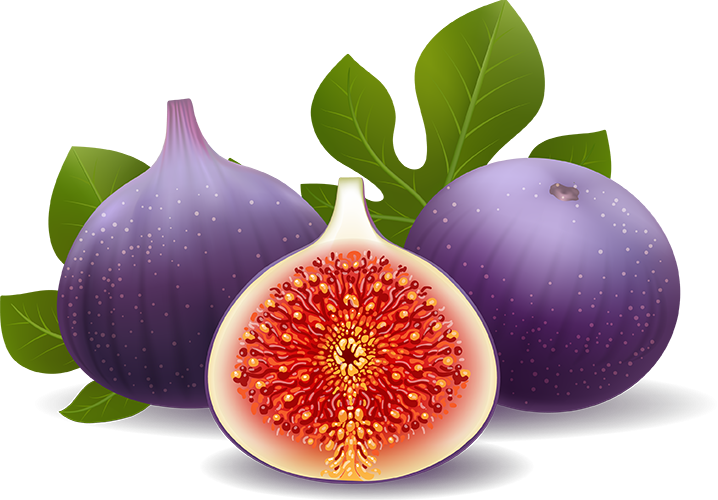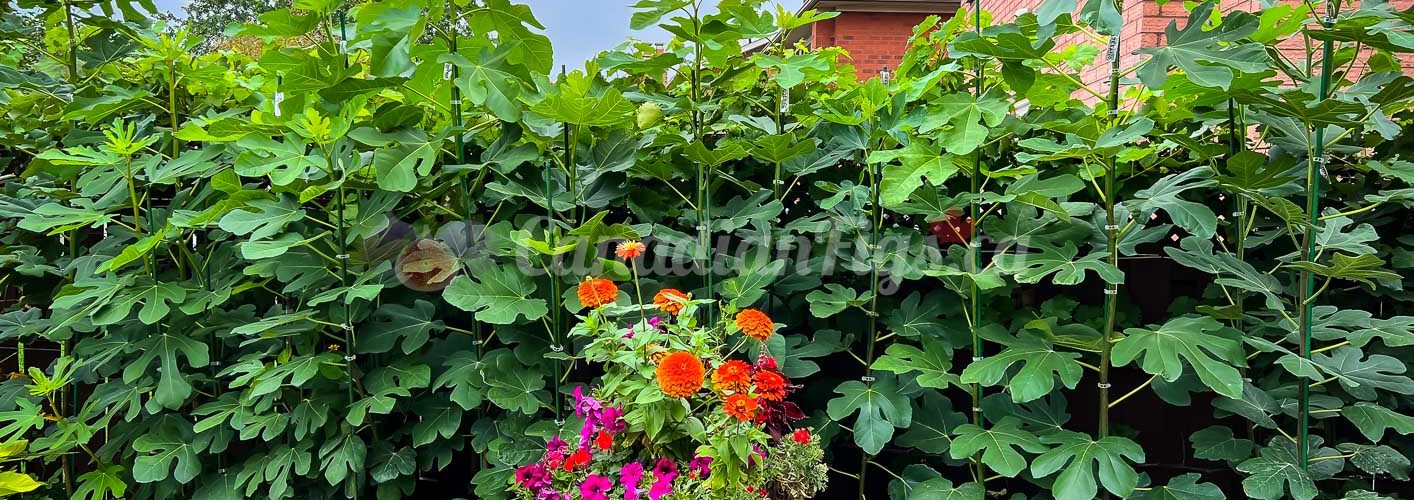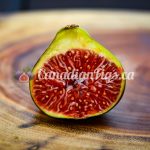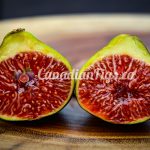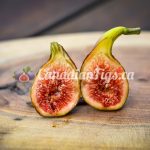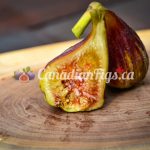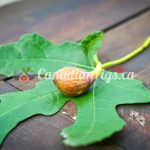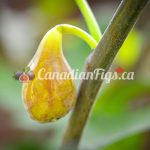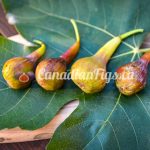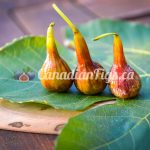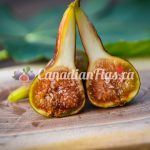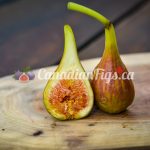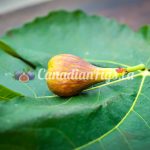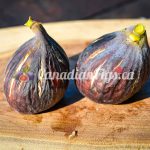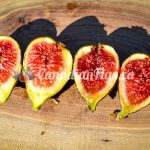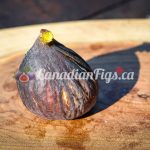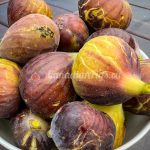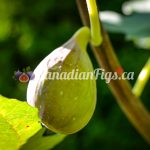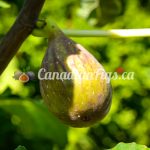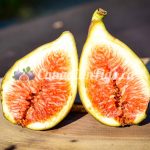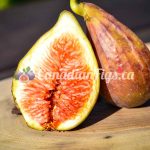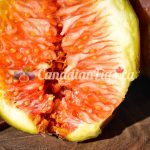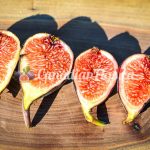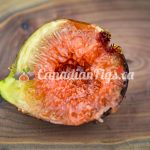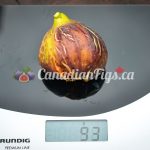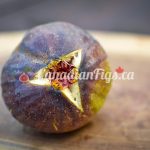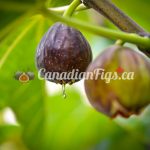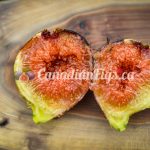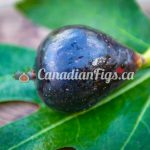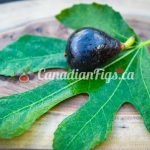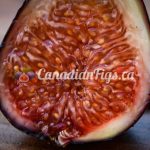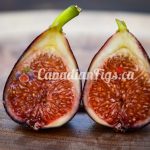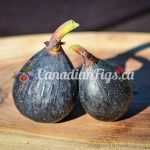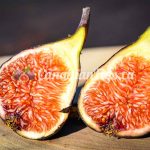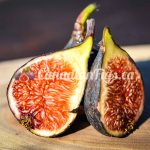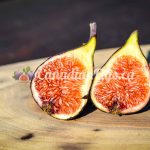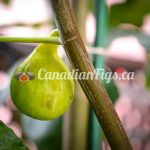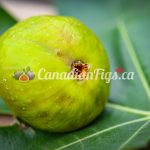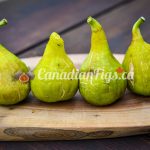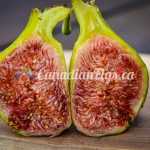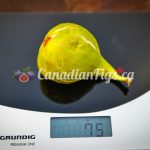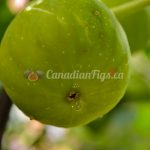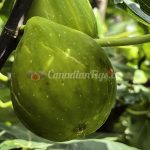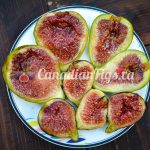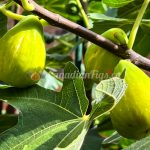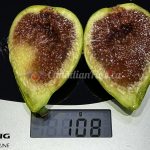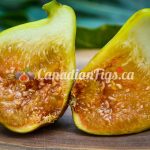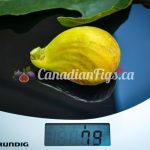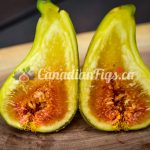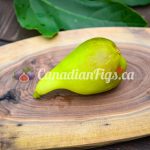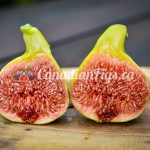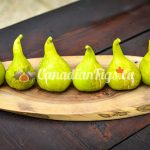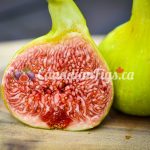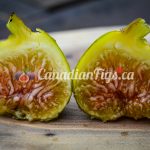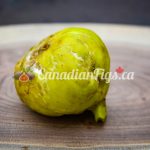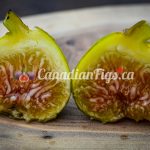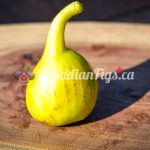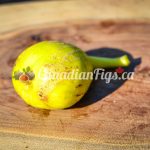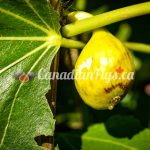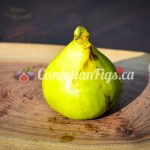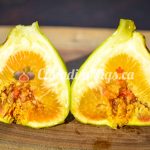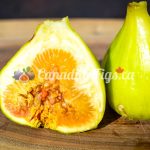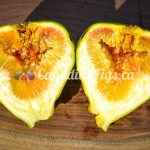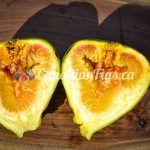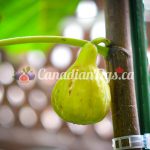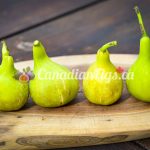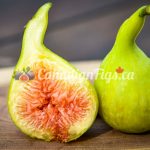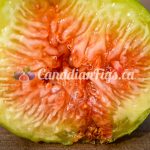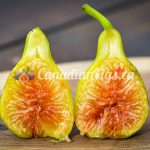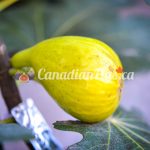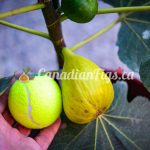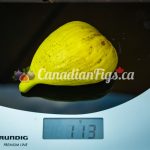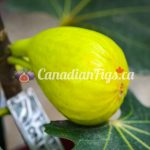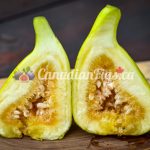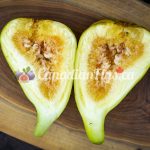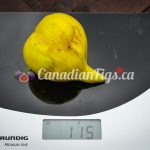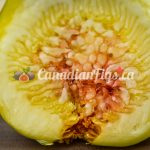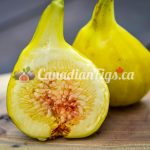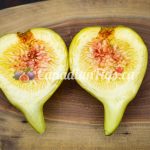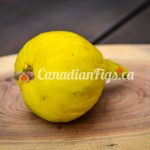General Fig Traits and Commonalities
There are many fig varieties in the world. Many fig cultivators and growers have increased the number of fig varieties that we enjoy today. The majority of these varieties are now available to you in Ontario, Canada today!!!
How to Successfully grow Fig Trees in Ontario and rest of Canada! Yes you can grow fig trees in Canada! You can grow Fig trees on your patio, on your porch, on your balcony, and in your own backyard!
Fig trees thrive and grow perfectly in containers with adequate winter protection. They are self pollinating and can be grown without pollinators or cross pollination. Fig trees require full sun to thrive and to produce a high yield of crops.
Cold Hardiness (Low, Medium, High): Although some fig trees have a higher cold hardiness resistance, Fig Trees are not cold hardy enough to survive Canadian winters unprotected. Protection is required for all fig trees during winter season regardless of cold hardiness ratings.
Crops per Season: Although some fig varieties may produce multiple crops in native and warmer conditions, due to the Canadian weather conditions and shorter summer periods, some of these fig trees may only produce one crop per season.
Fig Ratings: The star ratings assigned to various fig tree varieties are based on different factors such as: fruit quality, taste and flavor, reliability, productivity, proliferation, resistance and adaptability to Canadian climate, the specific variety strain that we have, as well as our own experience with the specific fig tree varieties. Not all fig tree varieties have been given a final rating yet. Some varieties are still pending assessments and require further consideration and analysis. Some varieties mature, reach peak productivity and fruit quality at different times and may also vary each season.
This page is divided into 2 sections. You can scroll or jump to sections by clicking on the links below:
Details and information may change. Updated: June 17, 2025
Purple / Dark Figs
Purple figs are probably the most common and known fig varieties. The following varieties are only some of the available purple and dark color fig varieties.
Antonio Black (KK)![]()
![]()
Antonio Black is a variant originating in the US deriving from KK (Keith Karausky who gave us the Black Madeira KK) in memory of his friend Anthony.
It is an initial aggressive grower under optimal conditions (have seen grow from cutting to 12 feet in first season). Impressive and will not disappoint.
Good fruit producer of medium sweet berry like figs but not overly sweet. The fruit is medium-size with a thick neck and dark purple skin and dark red flesh.
Origins: USA
Cold Hardy: Medium
Growth Rate: High/Fast
Tree Size: Medium-Large
Crops per Season: 1
Rating: Great
Fig Size: Medium
Fig Color: Purple
Fig Flavor: Mild Berry Flavor
Fig Sweetness: Sweet
Fruiting Period: Early Fall
References & Research:
https://www.youtube.com/watch?v=AekVSTkgNPI
Azores Dark![]()
![]()
![]()
The Azores Dark fig is a variant originating from the small Portuguese Island of Sao Miguel, in the Azores Islands. It has been reported and debated to be similar and maybe the same as Sao Miguel Roxo. It is believed to have been introduced to the islands by Portuguese settlers in the 15th century. The tree is known for its dark-colored fruit and its ability to withstand harsh weather conditions.
It is typically a fast grower with 2 crops per year in native conditions with a heavy second crop in the fall. In colder climates probably only the late fall crop.
Fruits are small to medium size with a dark purple skin with red flesh. Very intense berry flavor with a thick pulp but not too juicy. Jam-like consistency. They are not very juicy and are easy to dry in the sun.
The Azores Dark fig is praised for its heavy fruiting and its early and sweet second crop in the fall. It is a cold hardy and rain resistant variety that can be grown in containers. The Azores Dark fig is an excellent choice for every fig lover and collector.
Origins: Portugal
Cold Hardy: High
Growth Rate: High/Fast
Tree Size: Medium-Large
Crops per Season: 2*
Rating: Great
Fig Size: Small / Medium
Fig Color: Dark Purple / Red flesh
Fig Flavor: Intense Berry
Fig Sweetness: Sweet
Fruiting Period: Fall
References & Research:
https://www.youtube.com/watch?v=AekVSTkgNPI
https://www.youtube.com/watch?v=wFirN3e8so0
Beer’s Black
Beer’s Black is a Violette de Bordeaux variant/type and is actually often confused with VdB, Vista, and Black Mission. There seems to be also a dwarf version of it.
The origins of the black fig tree in relation to beer are unclear. Some speculate that the black fig tree was used in ancient brewing practices to add flavor and depth to the beer, while others believe that the tree simply grew near beer-making facilities and became associated with the drink over time. There is no concrete evidence to support either theory.
Fairly hardy, it is a good fruit producer of medium sized sweet rich berry figs with distinct flavor. The fruit has a very dark purple, violet skin with a deep red flesh. Medium sized eye. Great figs for fresh consumption and also making preserves.
Typically and varying based on locations, it produces an early breba in the spring and another one in the fall. It does well in most conditions.
Origins: USA
Cold Hardy: Medium
Growth Rate: Medium
Tree Size: Medium/Large
Crops per Season: 1/2
Rating: Good
Fig Size: Medium
Fig Color: Purple / Reddish pink flesh
Fig Flavor: Sweet berry rich fig flavor
Fig Sweetness: Sweet
Fruiting Period: Late Summer / Fall
Trees – Not Available
Cuttings – Not Available
Bisirri #3
The Bisirri #3 (also known as Bisirri Large 3 or Bissiri 3) is a unique fig variety with an intriguing history and notable characteristics.
The Bisirri #3 is tied to a story involving Mr. Bisirri in Philadelphia, Pennsylvania. It is believed to have originated from a neighbor’s fig tree that was stored in Mr. Bisirri’s greenhouse during winter, preserving its lineage.
The variety was popularized through Off the Beaten Path Nursery in Pennsylvania, where it was sold as a 1-gallon tree in 2020. It has since gained attention among fig enthusiasts as a “long-lost” cultivar.
It is described as a larger Mt. Etna variant, as a dark berry fig with a dark purple to black skin, with a sweet and complex flavour.
Origins: USA
Cold Hardy: Yes
Growth Rate: Medium/Fast
Tree Size: Medium/Large
Crops per Season: 1/2
Rating: Good
Fig Size: Medium
Fig Color: Purple
Fig Flavor: Dark Berry
Fig Sweetness: Sweet & Complex
Fruiting Period: Late Summer / Fall
Trees – Sold Out
Cuttings – Not Available
Black Madeira (KK) ![]()
![]()
![]()
Black Madeira KK is one of the most and highly sought-after fig variety.
This is an improved variant of the very popular Black Madeira variety which was originally brought to the US by Todd Kennedy from the island of Madeira, Portugal.
The Black Madeira fig tree is native to the island of Madeira, located off the coast of Portugal. It is believed to have been brought to the island by the Phoenicians or Romans. The tree has been cultivated on Madeira for centuries and is known for its sweet, dark fruits.
The Black Madeira KK, is named after Keith Karausky, who received it from Jon at Encanto Farms Nursery and propagated it through cuttings.
The Black Madeira KK is considered to be more vigorous than other Black Madeira strains. It is also more resistant to fig mosaic virus. It is known for its incredible fruits, rich, sweet, and complex flavor.
The Black Madeira KK fig is a late season variety that produces a heavy crop of medium to large fruits. It is not very cold hardy or rain resistant, so it is best grown in containers or in mild climates.
The Black Madeira, aka as The King of Figs, is considered to be one of the Top 5 best tasting Figs. The fruit is medium-size with a thick neck and dark purple skin and dark red flesh. It often has a honey sealing in the eye of the fig.
The Black Madeira KK fig is one of the most desirable figs for collectors and connoisseurs, as it offers a unique and unforgettable flavor experience
Origins: Portugal (USA)
Cold Hardy: Medium
Growth Rate: Lower/Slower
Tree Size: Medium-Large
Crops per Season: 1
Rating: Very High
Fig Size: Medium-Large
Fig Color: Dark purple
Fig Flavor: Sweet Berry Fruity
Fig Sweetness: Sweet
Fruiting Period: Late Fall
References & Research:
https://www.youtube.com/watch?v=ND9aq4hXpQU
https://www.youtube.com/watch?v=daqv89S0qEg
https://www.youtube.com/watch?v=C2hNmFotZvE
https://www.youtube.com/watch?v=ND9aq4hXpQU&t=88s
Black Mission
Black Mission, also known as the “Black Spanish” fig tree, is the most popular fig tree variety typically grown in California. It is the the dominant grown fig for fresh markets. It originated in the Mediterranean region, specifically in the area around present-day Tunisia and Sicily. Its history dates back to 1768 when it was introduced in California by Spanish missionaries and they named it the “Black Mission” fig due to its dark color and association with their missionary work.
Black Missions are the sweetest variety and widely grown throughout California with a molasses-caramel and assertive figgy unique and distinct flavor. This is also the most commonly dried fig. Figs have a blackish-purple skin with a strawberry flesh.
It produces best in hot and dry climates but it is successfully grown in colder climates in containers with proper winter care and storage (garage or greenhouse)
Origins: Spain
Cold Hardy: Low
Growth Rate: Moderate
Tree Size: Large
Crops per Season: 1/2
Rating: Good
Fig Size: Medium/Large
Fig Color: Dark Purple
Fig Flavor: Molasses-caramel figgy
Fig Sweetness: Very Sweet
Fruiting Period: Summer / Fall
References & Research:
https://en.wikipedia.org/wiki/Mission_fig
https://www.youtube.com/watch?v=EaXk6i9J__8
Trees – Not Available
Cuttings – Not Available
Black Zadar
The Black Zadar fig is a highly regarded variety known for its exceptional flavor, adaptability, and striking appearance.
Black Zadar has its origins in Zadar, Croatia. Seems to also be known as or maybe similar to “Črna Petrovca“. It has been traced back to Belleclare nursery in New York as being the first main distributor.
It is a very unique fig with an early ripening depending on the location and climate. Moderate vigor with sometimes 2 crops per season. Excellent main crop in late summer.
Produces medium size unique squatty flat bottom shape fruits with an excellent rich flavor.
The variety has gained popularity among fig enthusiasts in the United States, particularly for its cold hardiness and adaptability to different growing conditions.
Origins: Croatia
Cold Hardy: High
Growth Rate: Moderate
Tree Size: Medium-Large
Crops per Season: 1/2*
Rating: Great
Fig Size: Large / Medium
Fig Color: Purple-Black / Strawberry red flesh
Fig Flavor: Complex honey/melon & berry
Fig Sweetness: Sweet
Fruiting Period: Summer
References & Research:
https://www.youtube.com/watch?v=_eZwaIUsBcA
https://www.youtube.com/watch?v=lSk78iPWTM8
Trees – Sold Out
Cuttings – Sold Out
Bourjassotte Grise![]()
![]()
![]()
Bourjassotte Grise … although the French name, the fig name actually comes from the place where they came from: Bourjassot, a village in Spain, near Valencia. It is a very popular variety in Clumber, England where it seems to have been grown for many years under the name Blanche.
It has a characteristic deep purple skin, ribbed and cracked into a “beggar’s robes” pattern, which indicates the sweetness and quality of the fruit. The flesh inside is a deep purplish-red, with a sweet and slightly tart taste that balances the richness.
This fig is a one-crop variety, meaning it only produces one harvest per year, usually in late summer or early fall.
It is often compared to the Black Madeira fig, which is another highly prized fig with a complex berry flavor, but the Bourjassotte fig is not as intense and can produce larger and more abundant fruits.
It is one of Europe’s most famous figs, and has been grown in every country around the western Mediterranean since the 16th century.
It is a member of the Bourjassotte Noire fig family, which includes other varieties with black skin and red interior, such as Barnissotte, Bordissot Negra, Calderona, Calderona de Miner, Figue de Sollies, Negro Largo, and Noire De Barbentane.
It is a sugar and berry mix flavor group fig, which means it has a high sugar content and a fruity flavor that resembles berries, such as raspberry, strawberry, or blackberry.
Excellent variety. Top tier fig. A fast grower that ripens the fruits relatively sooner than other special varieties. It is very productive and reliable.
The fruits have an extremely strong, super rich, very sweet, delicious, syrupy, complex flavour. Ripens in approx 90-110 days depending on the season. Many say it has a much stronger flavour than even Pastiliere. It has a better skin than Figo Preto, Black Madeira, Craven’s Craving.
Figs are medium, roundish, flattened, brownish colour with patches of purple.
Origins: Spain
Cold Hardy: Medium
Growth Rate: High/Fast
Tree Size: Medium-Large
Crops per Season: 1
Rating: Very High
Fig Size: Medium
Fig Color: Brown/Purple
Fig Flavor: Dark Syrupy Berry
Fig Sweetness: Very Sweet
Fruiting Period: Late Summer/Fall
References & Research:
https://www.youtube.com/watch?v=R7ZjBGmegBg
https://www.youtube.com/watch?v=IX_GrIoh_N8
Trees – Sold Out
Cuttings – Sold Out
Brown Turkey
Brown Turkey is one of the most popular fig trees in USA and Canada. It produces abundant fruits in 2 crops a season (summer and fall).
The origins of the brown turkey fig tree are believed to be from the eastern Mediterranean region, specifically from Turkey. It is a variety of the common fig (Ficus carica) and has been cultivated for its sweet, juicy fruit for centuries. The brown turkey fig tree was introduced to North America by early European settlers and has since become a popular backyard fruit tree in many regions.
Brown Turkey figs have a brown-purple color skin with a pale pink/red flesh. They are milder in flavor and less sweet than other popular figs such as the Black Mission fig.
They are cold hardy, easily grown in colder climates and containers but they will require adequate winter protection.
Origins: Turkey
Cold Hardy: High
Growth Rate: High/Fast
Tree Size: Medium-Large
Crops per Season: 1/2*
Rating: Good
Fig Size: Medium
Fig Color: Brown /Red-Purple
Fig Flavor: Mild figgy melon / honey
Fig Sweetness: Mild Sweet
Fruiting Period: Early Summer / Fall
References & Research:
https://www.youtube.com/watch?v=6yAp9zTB4nI
https://plants.ces.ncsu.edu/plants/ficus-carica-brown-turkey/#:~:text=’Brown%20Turkey’%20is%20a%20cultivar,large%20deeply%20lobed%20rough%20leaves.
Trees – Not Available
Cuttings – Not Available
Celeste![]()
![]()
The Celeste Fig, also known as the “Sugar Fig”, is a very popular Fig Tree with an early ripening period and before most of the other fig varieties. It is very popular and a favorite fig tree grown in California and Southern United States. Celeste can be easily grown in Canada with adequate winter protection. Celeste will produce an abundant amount of fruits.
It is also known as Celestial, Honey, or Sugar fig because of its sweet and sugary taste that resembles honey1. It has a smooth, rose to violet-colored skin with a closed eye that prevents insect and disease damage. The flesh inside is bright pink and juicy, with a rich and complex flavor.
This fig is a one-crop variety, meaning it only produces one harvest per year, usually in late summer or early fall. It is a cold-hardy and drought-tolerant fig that can grow up to 15 feet tall if left unpruned, but it can also be grown in containers and kept smaller. It is a self-pollinating fig that does not require a fig wasp for fruit production.
It is one of the oldest fig varieties in the United States, dating back to the 16th century when it was introduced by Spanish explorers in Florida.
It is a member of the Common fig group, which includes other varieties with closed eyes and edible skins, such as Brown Turkey, Brunswick, and Mission.
It is a sugar and berry mix flavor group fig, which means it has a high sugar content and a fruity flavor that resembles berries, such as raspberry, strawberry, or blackberry.
It is often used for making preserves, jams, and pies, as well as eaten fresh or dried.
It produces medium size figs with a very sweet flesh, light berry flavor, a bit of chewy texture with crunchy seeds. Fig color ranges from brown, green, and purple based on the sun exposure.
The Celeste Fig is heat tolerant, has an increased resistance to pests, diseases, humidity, and splitting when ripe.
Origins: USA
Cold Hardy: Medium/High
Growth Rate: Medium
Tree Size: Medium
Crops per Season: 1
Rating: Great
Fig Size: Medium
Fig Color: Brown / Purple
Fig Flavor: Smooth Rich Flavor
Fig Sweetness: Very Sweet
Fruiting Period: Late Summer
References & Research:
https://www.youtube.com/watch?v=lvz9flose9s
https://www.youtube.com/watch?v=zs-gZUfbBaI
https://www.youtube.com/watch?v=FdSCvBSQ89M
https://www.youtube.com/watch?v=lvz9flose9s&t=2s
Celeste Blue (Blue Celeste)![]()
![]()
![]()
The Blue Celeste Fig,.. also known as “The One” is a derivation of the original Celeste. Seems like a smaller LSU Tiger. Shorter hang time due to smaller size.
Robust grower, reliable and very productive. Excellent producer in all climates.
Typically all Celeste figs are very consistent and reliable all the time, every season. Hence the derivation of so many Celeste varieties from the original Celeste. Produces consistently very reliable fruits. LSU used Celeste as their main fig variety in all their breeding programs at the LSU AG.
Fruits are very similar to Celeste but more fruity with better flavour. Flavors intensify as the fruits dry further on the tree.
Origins: USA
Cold Hardy: Medium
Growth Rate: Medium/Large
Tree Size: Medium/Large
Crops per Season: 1
Rating: High
Fig Size: Medium
Fig Color: Brown / Purple
Fig Flavor: Figgy/Berry
Fig Sweetness: Sweet
Fruiting Period: Late Summer.
References & Research:
https://www.youtube.com/watch?v=G1ziV_MfUU8
https://www.youtube.com/watch?v=AJm5vv3RhqU
https://www.youtube.com/watch?v=VNo854nBbiQ
Trees – Sold Out
Cuttings – Sold Out
Celeste Improved![]()
![]()
![]()
The Improved Celeste Fig is considered a workhorse fig. The Improved Celeste fig variety is an “improved” version of the Celeste with a longer harvest, less fruit drop, and more hardy than the regular Celeste. Early ripening fig.
The Improved Celeste Fig, often simply referred to as ‘Improved Celeste,’ is a highly regarded fig variety known for its early ripening, high productivity, and excellent fruit quality.
This variety is an enhancement of the traditional Celeste fig, which is also known for its sweet flavor and small to medium-sized fruits. The Improved Celeste inherits many of the desirable traits of its predecessor but with some distinct advantages that make it a favorite among fig enthusiasts and gardeners alike.
The Improved Celeste produces small to medium-sized fruits, typically about 1.5 to 2 inches in length. The fruits have a somewhat pear or teardrop shape, which is characteristic of many fig varieties. This shape facilitates easy drying and storage.
The skin of the Improved Celeste fig is relatively thin, which contributes to its delectability but also means it’s slightly more delicate when handled. The color is a beautiful light brown to violet at full maturity, with the skin sometimes showing a slight green hue at the shoulders early in the ripening process.
The pulp is a vibrant amber to pink color, offering not just a visual treat but also a texture that is both dense and smooth. The seeds are small and numerous, adding a pleasant crunch that contrasts with the soft flesh. The pulp’s consistency and the balance of seeds contribute to its exceptional eating quality.
The Improved Celeste is celebrated for its exceptionally sweet taste, often described as reminiscent of honey, caramel, and a hint of berries. This sweetness is well-balanced, not cloying, making it a favorite for fresh consumption.
The figs emit a subtly sweet and fruity aroma that enhances the overall sensory experience. This fragrance is especially pronounced in freshly picked fruits and contributes to the fig’s appeal, not just as a food item but also as a sensory delight in the garden.
The Improved Celeste fig is a variety that embodies a blend of aesthetic appeal, nutritional value, and culinary versatility. Its early ripening period, coupled with the tree’s resilience and adaptability to various climates, makes it a worthy candidate for both novice and experienced gardeners.
The figs themselves, with their distinct flavor and texture, offer a delightful eating experience, whether consumed fresh or processed. The Improved Celeste’s combination of desirable traits ensures its place as a valued cultivar in the world of fig cultivation.
Origins: USA
Cold Hardy: Medium/High
Growth Rate: Medium
Tree Size: Medium-Large
Crops per Season: 1
Rating: Great
Fig Size: Medium
Fig Color: Brown / Purple
Fig Flavor: Smooth Rich Flavor
Fig Sweetness: Very Sweet
Fruiting Period: Late Summer
References & Research:
https://www.youtube.com/watch?v=iTZOgLGqiKY
https://www.youtube.com/watch?v=V6YaYiUc5ws
https://www.youtube.com/watch?v=8N7OvwSDfNo
Chicago Hardy![]()
![]()
![]()
Chicago Hardy figs are one of the most known varieties in cold climates. They are famous for their cold-hardiness, easygoing nature, versatile fruit use and also their abundant yield. Mature Chicago Hardy fig trees can bear upwards of hundreds of figs per season.
It is unclear when and how it was exactly discovered but there are different origin stories that it was discovered in Chicago in the 1980’s where it was found growing without any winter protection.
It is believed that it was developed in the early 1900s by a horticulturist named Frank Crane in Chicago, Illinois and that it was specifically bred to be resistant to cold temperatures and to thrive in the challenging climate of the Midwest.
Chicago Hardy fig tree is believed to be a cross between two other fig varieties, the Brown Turkey fig and the White Adriatic fig, and origins to Mount Etna, Sicily, Italy.
Arguably the most notable feature of the ‘Chicago Hardy’ fig is its exceptional cold hardiness. It is capable of surviving winter temperatures down to -10°F (-23°C), especially with some protection or if planted in a sheltered location. Even when the above-ground portion of the plant is killed by frost, it can regrow from the roots and still produce fruit within the same year.
This variety exhibits a robust growth pattern, reaching heights of 15-30 feet if left unpruned, but can be maintained at a smaller size through regular pruning. Its growth habit is bushy, with multiple stems emerging from the base, which contributes to its ability to recover from dieback caused by freezing temperatures.
Highly adaptive, very cold hardy, and well suited for growing in containers with a fast growth rate.
The fruits of the ‘Chicago Hardy’ fig are of medium size, typically reaching about 2 to 3 inches in length. They have a round to slightly elongated shape, which is characteristic of many fig varieties, facilitating easy picking and processing.
The skin of the fruit is relatively thin but resilient, which allows for easy eating without the need for peeling. Its deep purple to black coloration when ripe not only makes it visually appealing but also helps in determining the fruit’s ripeness.
The pulp is a vibrant, rich red or pink, noted for its juicy and lusciously sweet flavor profile, often described as having hints of berry. The presence of numerous small seeds within the pulp adds a subtle texture contrast, enhancing the eating experience.
The ‘Chicago Hardy’ fig is distinguished by its resilience to cold, productive fruiting capability, and versatility in use.
Its ability to bounce back after harsh winters, coupled with the ease of care and nutritional benefits of its fruits, makes it a favored choice among fig cultivars, especially for those in cooler climate zones. Whether planted for its ornamental beauty, its delicious fruits, or its adaptability to small spaces, the ‘Chicago Hardy’ fig offers something for every gardener.
Highly Recommended.
Recommended to be associated or paired with Dalmatie, Desert King, Celeste Improved, for greater coverage of early to late fall crops and fruit harvesting periods.
Origins: USA / Italy
Cold Hardy: High
Growth Rate: High/Fast
Tree Size: Medium-Large
Crops per Season: 1-2
Rating: High
Fig Size: Medium
Fig Color: Purple
Fig Flavor: Light, sweet, and strawberry
Fig Sweetness: Sweet
Fruiting Period: Late Summer/Fall
References & Research:
http://planetfig.com/cultivars/fcveng8623.html
https://www.youtube.com/watch?v=-0fzQBYL1Zc
Ciccio Nero
Ciccio Nero is a Mt Etna type fig. More details coming soon.
Cold hardy. Easy to grow.
Prolific and highly productive with a fig on every node.
Excellent tasting. Medium size figs with deep purple/black skin.
Excellent growing in colder climates.
Origins: Italy/Canada
Cold Hardy: Very
Growth Rate: High/Fast
Tree Size: Medium/Large
Crops per Season: 2
Rating: Great
Fig Size: Medium
Fig Color: Purple
Fig Flavor: Berry
Fig Sweetness: Moderately Sweet
Fruiting Period: Late summer/ Early Fall
References & Research:
Trees – Sold Out
Cuttings – Not Available
Col de Dame Mutante![]()
![]()
![]()
The Col de Dame Mutante fig, is a mutation of Col de Dame Noir. Fruit starts green and it starts to become variegated as it ripens. The stripes become more pronounced as it ripens.
Col de Dame varieties are said to be one of the finest tasting figs in the world, with delicious flavors that are highly desirable among fig connoisseurs. It produces one crop late in the season, and no pollination is needed for fruit production.
In summary, the Col de Dame Mutante fig is a variety that stands out for its exceptional taste, attractive appearance, and the unique characteristics of its fruit. It’s a variety that fig enthusiasts seek out for its rich flavor profile and historical significance
Origins: France
Cold Hardy: Medium
Growth Rate: High/Fast.
Tree Size: Medium-Large
Crops per Season: 1
Rating: Very High
Fig Size: Medium
Fig Color: Purple/Black
Fig Flavor: Berry/Honey
Fig Sweetness: Sweet
Fruiting Period: Late Fall
Col de Dame Noir![]()
![]()
![]()
The Col de Dame Noir fig, also known as Coll de Dama Negra, is a highly esteemed variety that originates from France. It is renowned for its high-quality, medium-sized figs that boast a dark brown to almost black color. The skin of this fig is thin and resilient, not prone to damage easily, which is a desirable trait for figs. One of the distinctive features of the Col de Dame Noir is its elongated neck, which is reminiscent of the high collars fashionable in French royalty, hence the name “Collar of a Lady” or “Collier d’une Dame”
The pulp of the Col de Dame Noir fig is dark red and has a jam-like consistency—thick, heavy, and not watery, making it very satisfying to bite into. The white part of the fig, or the ‘meat,’ can be quite thick, and if the fig is left to hang on the tree, the sugars and pulp will concentrate, resulting in a clear delineation between the meat and pulp when cut open. This outline is another typical trait of the Col de Dame varieties and adds to the clean look of the fruit.
Flavor-wise, the Col de Dame Noir fig is described as very complex and rich, with a medium sweetness and berry undertones that make it stand out among other figs. It has a small seed crunch and no cavity, with a tight eye, making it a great variety for potted culture. The tree itself is very hardy but requires lots of sun and a longer growing season than most
This variety is said to be one of the finest tasting figs in the world, with a delicious flavor that is highly desirable among fig connoisseurs. It produces one crop late in the season, and no pollination is needed for fruit production. The Col de Dame Blanc and Col de Dame Noir are considered favorites for late-season
In summary, the Col de Dame Noir fig is a variety that stands out for its exceptional taste, attractive appearance, and the unique characteristics of its fruit. It’s a variety that fig enthusiasts seek out for its rich flavor profile and historical significance
Origins: France
Cold Hardy: Medium
Growth Rate: High/Fast.
Tree Size: Medium-Large
Crops per Season: 1
Rating: Very High
Fig Size: Medium
Fig Color: Purple/Black
Fig Flavor: Berry/Honey
Fig Sweetness: Sweet
Fruiting Period: Late Fall
Colasanti Dark
Colasanti Dark has its origins at the Colasanti farms /nursery in Canada and it is a variation of Italian Sicilian fig tree.
Produces medium size brown-purple skin with red flesh figs with a great sweet berry taste. It has a bright red pulp and a sweet and fruity flavor that resembles blueberry and honey.
Very cold hardy and easy to grow in containers. Requires adequate winter protection
Origins: Canada (Italy)
Cold Hardy: Very
Growth Rate: High/Fast
Tree Size: Medium-Large
Crops per Season: 1
Rating: Good
Fig Size: Medium
Fig Color: Purple
Fig Flavor: Berry
Fig Sweetness: Sweet
Fruiting Period: Late Summer / Fall
Craven’s Craving![]()
![]()
![]()
Craven’s Craving is a fig variety that was discovered by a fig enthusiast named Chris, also known as Padsfan, in the Point Loma neighborhood of San Diego, California. The fig tree was originally brought from Portugal and is known for producing excellent black-skinned figs with a red interior. The taste of the figs from this tree has been described as some of the sweetest and best tasting figs ever experienced.
The Craven’s Craving fig tree was brought to San Diego from Portugal. The original owner of the tree came to San Diego to fish for tuna when the city was known as the tuna capital of the world, which attracted many Portuguese and Italians from the 1930s-1960s.
The figs have a black outer skin layer that is chewy and admirable from both near and far. The pigmentation is unique, setting it apart from other fig varieties.
The figs are described as having a delicious taste, even when ripening in December, which is notable considering the colder and rainier weather during that time of year in San Diego
It belongs to the main flavor group of Black Madeira type figs
The main season for Craven’s Craving figs is mid-season
The figs have a mild seed crunch. The eye of the fig is small.
The skin is described as chewy. The fruit size is medium.
The Craven’s Craving fig is an excellent choice for those looking for a unique fig variety with a rich history and a delicious flavor profile. Its distinctive black skin and red interior make it a standout among fig varieties, and its taste is highly praised by those who have had the opportunity to try it
Origins: USA / Portugal
Cold Hardy: Medium
Growth Rate: High/Fast
Tree Size: Medium-Large
Crops per Season: 1
Rating: Very High
Fig Size: Medium
Fig Color: Purple
Fig Flavor: Rich complex Berry
Fig Sweetness: Sweet
Fruiting Period: Fall
Trees – Sold Out
Cuttings – Sold Out
De Tres Esplets
De Tres Esplets is native and cultivated in Campos, Mallorca, Spain. The name is derived from 3 crops which it produces in its native conditions. Great for cold climates and short seasons with early ripening.
Very prolific and productive. Produces medium, round deep purple fruits with a pink flesh. Mild melon and honey flavor, the fruits are sweet and sugary.
Easy to grow with an early ripening that may not require a head start like other varieties.
Origins: Spain
Cold Hardy: Medium
Growth Rate: High/Fast
Tree Size: Medium-Large
Crops per Season: 1-3
Rating: High
Fig Size: Medium
Fig Color: Deep Purple
Fig Flavor: Melon / Honey
Fig Sweetness: Sweet
Fruiting Period: Summer/Fall
References & Research:
https://es.wikipedia.org/wiki/De_Tres_Esplets
https://www.youtube.com/watch?v=-Zni_zcQfyc
Emalyn’s Purple
Emalyn’s Purple is a French variety named after a cultivars’ wife. It was discovered in Sacramento. It is an improved derivation of Negronne. Extremely vigorous and prolific.
Produces medium to large size round fruits with rich and complex flavor better than Negronne’s. Even when not ripened, the fruits have a sweet-tart flavor.
Very similar or same as Negronne, Violette de Bordeaux, and Vista.
Origins: USA
Cold Hardy: Medium
Growth Rate: High/Fast
Tree Size: Medium-Large
Crops per Season: 1/2
Rating: Great
Fig Size: Medium
Fig Color: Purple
Fig Flavor: Rich complex berry
Fig Sweetness: Sweet
Fruiting Period: Late Summer
References & Research:
https://www.youtube.com/watch?v=c-thfUL5-88
Exquisito![]()
![]()
![]()
Exquisito fig is a unique and relatively new variety that has quickly gained popularity among fig enthusiasts.
The Exquisito fig originates from California and was popularized by a grower known as Doug (Bluemalibu).
The Exquisito fig undergoes a remarkable transformation during its ripening process. It starts as a green fig, then develops rimada-striped patterns, and finally turns pitch black with a starry fielded exterior when ripe
The Exquisito fig produces three crops. The first crop ripens in late July to early August, and the second crop in late October to early November. Both of these crops have black skin with a starry white field. The third crop ripens in December and has a gray (smoky greenish/purple) exterior with a strong Banana / Strawberry Yogurt flavor.
The first two crops of the Exquisito fig are known for their very sweet, fruity/berry flavor. Steve (fruitnut), a fig connoisseur, rated the flavor as 9/10, which is on par with other esteemed varieties like Thermalito and Preto.
Exquisito fig is suitable for container growing. The figs have a mild seed crunch. The eye of the Exquisito fig is open. The skin is soft. The fruit size is medium.
The Exquisito fig tree is one of the most exciting selections to come out of the naturalized fig seedlings of California
The Exquisito fig is celebrated for its distinctive appearance and exceptional flavor profile. Its ability to produce multiple crops with varying flavors makes it a versatile and exciting variety for fig lovers. The tree’s adaptability to container growing also makes it accessible for those with limited space or in urban settings. If you’re interested in cultivating this variety, it’s a great choice for its unique characteristics and delicious taste
Origins: USA
Cold Hardy: Medium
Growth Rate: High/Fast
Tree Size: .Medium-Large
Crops per Season: 1-3
Rating: …
Fig Size: Medium
Fig Color: Black/Purple
Fig Flavor: Berry/Fruity
Fig Sweetness: Very Sweet.
Fruiting Period: Late Summer/Fall
Figo Preto![]()
![]()
![]()
Figo Preto Fig is a highly regarded variety known for its exceptional taste and quality. The Figo Preto fig was found growing in Point Loma, California, by a Portuguese lady, where it has been growing for about 50 years. It was discovered in 2008. However, it is not a Portuguese fig, and there is no Figo Preto in Portugal. Some say it is similar or the same as Violeta.
Figo Preto is a dark, medium-sized fig. It is widely reported as very similar to Black Madeira but ripens earlier in many cases. The figs are delicious and among the best tasting figs. They have a deep yet balanced fruity flavor, moderate sweetness, and a syrupy texture. Often, they produce honey at the eye.
The figs have a mild seed crunch. The eye of the fig is small. The skin is described as chewy or leathery. The fruit size is medium to large.
It belongs to the Dark Berry flavor group and is thought to be the same as Black Madeira but ripens fruit earlier and is more productive.
The Figo Preto fig is a robust clone of the renowned “Black Madeira” fig variety, originally coming from the island of Madeira, Portugal. This variety is known for producing very dense and sweet, black figs with a burgundy red flesh.
It is a far more vigorous, faster-growing, producing figs that are essentially identical to the “true” Black Madeira (DFIC 144), but with much less fuss and patience needed.
Given its exceptional flavor and ease of growth compared to other similar varieties, the Figo Preto fig is a favorite among fig enthusiasts and is considered a must-have for any fig collection
Origins: USA/Portugal
Cold Hardy: Low/Medium
Growth Rate: High/Fast
Tree Size: Medium-Large
Crops per Season: 1
Rating: Very High
Fig Size: Medium/Large
Fig Color: Purple
Fig Flavor: Rich complex berry
Fig Sweetness: Sweet
Fruiting Period: Fall
Florea![]()
![]()
![]()
The Florea fig is known for its exceptional cold hardiness and early ripening, making it an excellent choice for fig enthusiasts in cooler climates.
The Florea fig was introduced to America from Serbia by a fig enthusiast known as Herman. It was brought from his homeland and named for his father. The variety is thought to have originated from his father’s garden in Serbia.
Florea is among the hardiest varieties known, surviving temperatures as low as -4°F in New Jersey. In Serbia, it reportedly survived temperatures of -13°F12.
It is often the earliest to ripen its main crop, usually in late July or early August. This makes it one of the first figs to enjoy during the season.
The Florea fig is a sweet fig with a good but not extraordinary taste. It can develop light fruity/berry tones as the tree matures and the figs are allowed to fully ripen. The taste of the fruit changes significantly during the season, starting with a “fig” + “caramel” aroma and acquiring a nuance of berries towards the end. When dried, the berry taste becomes more pronounced.
It is an extremely strong producer, fruiting covers the whole season from early August until cold. Trees do not need special care.
It is an aggressive grower and very productive, making it a valuable addition to any fig collection.
The figs are small to medium in size, with a brown color and sweet flavor often with some caramel overtones.
Florea produces a breba crop, which is the fruit that grows on the previous year’s shoot growth and ripens in the early summer.
Florea is thought to be a synonym for Michurinska-10, which is the most common fig variety in Bulgaria. The name was given more than 50 years ago by Radka Serafimova during her scientific research on varieties of figs in Bulgaria. Florea’s ability to survive cold temperatures and produce an early crop makes it a standout variety for those in northern regions looking to grow figs. If you’re considering adding this variety to your garden, it’s a great choice for its resilience and early harvest.
Origins: USA/Serbia
Cold Hardy: High
Growth Rate: High/Fast
Tree Size: Medium-Large
Crops per Season: 1/2
Rating: Great
Fig Size: Medium
Fig Color: Brown
Fig Flavor: Light Fruity/Berry
Fig Sweetness: Sweet
Fruiting Period: Early Summer.
Trees – Sold Out
Cuttings – Sold Out
Galicia Negra
Galicia Negra has been widely considered to be one of the best Black Mission varieties. but it may take 1-2 extra years to produce larger amounts of fruits.
It is a fig tree from Spain grown in the Galicia area and is different than the true Napolitana Negra.
The fig tree is a very aggressive grower.
It produces medium-large size dark purple figs with a very dark flesh (almost purple) and a thick and chewy texture. It has a very sweet and jammy fruit flavor. Very unique and delicious. Moderate seed crunch.
Origins: Spain
Cold Hardy: Medium
Growth Rate: High/Fast
Tree Size: Medium-Large
Crops per Season: 1
Rating: High
Fig Size: Medium / Large
Fig Color: Purple / Purple flesh
Fig Flavor: Jammy
Fig Sweetness: Sweet
Fruiting Period: Fall
References & Research:
https://www.youtube.com/watch?v=Iv5SO_TbNNU
https://www.youtube.com/watch?v=Lgi1lvtu7pk
Genovese Nero AF![]()
![]()
![]()
The Genovese Nero AF has its origins in Northern Italy’s Genoa region. It has been brought to North America by Adriano Ferreira (AF) in Canada. The AF variety of the Genovese Nero is an improved and superior variety which was distributed at some nurseries in the Toronto area.
Reported similarity I258 (Italian 258).
This is a premium fig tree, very vigorous with an aggressive growth, and great weather resistance.
Produces large purple delicious figs with great resistance to splitting during rainy seasons. Figs have a deep black skin with a bright red flesh. Great sweet berry flavor. Fruits ripen in early-mid fall.
Origins: Italy
Cold Hardy: Medium
Growth Rate: High/Fast
Tree Size: Medium-Large
Crops per Season: 1
Rating: Very High
Fig Size: Medium/Large
Fig Color: Deep purple / red flesh
Fig Flavor: Berry
Fig Sweetness: Sweet
Fruiting Period: Early-Mid Fall
References & Research:
https://www.youtube.com/watch?v=KEiVQXxDYbg
https://www.youtube.com/watch?v=vgSrHnVXr-s
Gisotta Nero
Gisotta Nero is a Sicilian Dark Red Fig. Great fig for cold climates with moderately vigor. Great resistance to rain periods without splitting.
Excellent Breba (first crop) production in early summer.
Fruits are juicy, sweet, with a rich complex flavor of jammy berry. Very thin skin with a deep red color.
Origins: Italy
Cold Hardy: Medium
Growth Rate: Medium
Tree Size: Medium
Crops per Season: 1/2
Rating: Good
Fig Size: Medium
Fig Color: Dark Red
Fig Flavor: Figgy, Jammy, Berry
Fig Sweetness: Sweet
Fruiting Period: Early summer
Hative d’Argenteuil (HDA)
The Hative d’Argenteuil fig is a French variety with a name that translates to “early Argenteuil,” indicating its early ripening characteristic. It was mistakenly referred to as “Native d’Argenteuil” at the University of California-Davis.
This variety is known for its modest growth and prolific production of figs that have a purple and green exterior and a bright red interior. The figs are praised for their excellent berry flavor and are recommended to be given full sun and plenty of water for optimal growth.
The Hative d’Argenteuil fig is described as having an intense flavor similar to the Bourjasotte Grise variety.
The fig skin is soft and flavorful. The figs are small, oblique-spherical, with a short, thick neck, and violet in color. The pulp is strawberry-colored, and the quality is good. The fruits commonly dry without spoilage.
Additionally, the Hative d’Argenteuil figs are known for their bright red pulp with an intense, concentrated flavor. The balance of berry, honey, and sweet flavors is complemented by a touch of lemony acidity. Even the skin is sweet and tender, and the figs can be left on the tree for an even more concentrated flavor without the worry of souring.
Overall, the Hative d’Argenteuil fig is a delightful variety that offers a unique taste experience and is suitable for those looking for an early-ripening fig with a rich berry flavor profile. Its ability to dry on the tree without spoiling makes it an excellent choice for growers interested in drying figs
Origins: France
Cold Hardy: Medium
Growth Rate: Moderate
Tree Size: Medium.
Crops per Season: 1
Rating: Very High
Fig Size: Small/Medium
Fig Color: Purple/Green
Fig Flavor: Berry
Fig Sweetness: Very Sweet
Fruiting Period: Late Summer
Trees – Sold Out
Cuttings – Sold Out
I258 (Italian 258)![]()
![]()
![]()
The Italian 258 Fig tree is a fig variety that originated in Italy. It is known for its large fruit size and high yield. It is believed to have been developed through selective breeding by Italian fig farmers and gardeners who selected and bred fig trees with desirable characteristics, such as high yields, sweet fruit, and resistance to diseases and pests.
It was brought to North America from Italy by Todd Kennedy in the 1980s. The “258” in its name refers to Todd’s numbering for the imported figs.
The Italian 258 fig tree produces large, juicy figs that are light green-brown in color with a sweet, rich flavor. Figs are rated very high and in the same category as Black Madeira, VdB, RdB, etc. The fig quality is very impressive, produces excellent quality fruits.
Highly sought, highly recommended and a must have variety.
Origins: Italy
Cold Hardy: Medium
Growth Rate: High/Fast
Tree Size: Medium-Large
Crops per Season: 1
Rating: Very High
Fig Size: Medium-Large
Fig Color: Light Brown
Fig Flavor: Very Berry
Fig Sweetness: Sweet
Fruiting Period: Late Summer / Fall
References & Research:
https://www.youtube.com/watch?v=Mj6NPnY2aL0
https://www.youtube.com/watch?v=uIYHrq5myUc
https://www.youtube.com/watch?v=oevLSAHoRpU
https://www.youtube.com/watch?v=-trnj5sa4JU
(36) Italian 258 Breba – July 8, 2023 – YouTube
Long D’Aout (LDA)
The origins of the Long d’Aout (LDA) fig tree are uncertain. It is believed to have originated in the Mediterranean region, possibly in the region of Tunisia or Algeria. It is also possible that it originated in Asia Minor and was introduced to the Mediterranean region by traders or travelers. The tree thrives in warm and sunny climates and is commonly found in Mediterranean regions. It has a long lifespan and can live for hundreds of years.
Longue d’Aout fig tree is also known as Nordland in Switzerland, Melanzana Merdascola, Cucumber and other names. Longue d’Aout fig tree is more rustic looking on the outside, with a thick fleshy fig. Longue d’Aout fig tree is a breba favored fig, as the brebas are better than the main crops in taste and quality. The tree is known for its ability to produce an abundance of fruit.
Long d’Aout is known for its tall, slender stature, narrow crown, smooth bark, and its elongated, drooping branches. The leaves of the tree are typically dark green and glossy. The tree is often used as a shade tree in gardens and landscaping, and its fruit is often used in culinary dishes and as a natural sweetener.
Longue d’Aout produces long, green-skinned juicy figs with red pulp. Longue d’Aout figs have a large and flavorful, dense pulp with a sweet melon-like flavor.
Longue d’Aout fig tree is one of the earliest ripening figs and one of the top figs for short seasons and tough conditions.
Cold Hardy: Medium
Growth Rate: High
Tree Size: Medium-Large
Crops per Season: 1/2
Rating: High
Fig Size: Large
Fig Color: Green
Fig Flavor: Melon
Fig Sweetness: Very Sweet
Fruiting Period: Summer / Fall
References & Research:
https://www.youtube.com/watch?v=JOruQrfjcmg
https://www.youtube.com/watch?v=9xS7PlIYPto
https://www.youtube.com/watch?v=h1cVYAjczTI
LSU Purple![]()
![]()
LSU Purple (Louisiana State University) was part of the varieties released by the LSU fig breeding program. It was created by cross-breeding two fig varieties, the Celeste fig and the Alma fig, to create a tree that was resistant to the harsh climate and soil conditions of Louisiana.
The resulting tree produces a sweet, purple fruit with amber flesh, that is popular among local residents and is often used in cooking and baking.
The fruit has a deep purple color with a closed eye. It is mildly sweet with a light berry flavor.
When compared with RdB and VdB, it seems that it ripens later than both by 1-2 months. Flavor also seems to be lighter and not as pronounced as VdB.
Origins: USA
Cold Hardy: Medium
Growth Rate: High/Fast
Tree Size: Medium-Large
Crops per Season: 1
Rating: High
Fig Size: Medium
Fig Color: Purple / Amber flesh
Fig Flavor: Candy, caramel sugar
Fig Sweetness: Moderately Sweet
Fruiting Period: Late Fall
References & Research:
https://www.youtube.com/watch?v=3EoQZCV_p10
https://www.youtube.com/watch?v=_bixaJnpTiQ
LSU Scott’s Black![]()
![]()
LSU Scott’s Black (Louisiana State University) Fig was released by the LSU fig breeding program.
It was developed by the Louisiana State University Agricultural Center in Baton Rouge, Louisiana and it is named after the late Professor Scott, a horticulturist at the university who is credited with developing the cultivar. The tree is known for its large, delicious, dark-purple fruits with strawberry pink flesh, and its ability to tolerate hot and humid climates.
Figs are very rich, sweet with an intense and unmatched flavor.
Excellent canopy and spread, easily managed for container growing. Very vigorous and very productive.
Not as cold hardy as other varieties but it is successfully grown in colder climates in containers with proper winter care and storage (garage)
Origins: USA
Cold Hardy: Medium
Growth Rate: High/Fast
Tree Size: Large
Crops per Season: 1
Rating: High
Fig Size: Medium
Fig Color: Purple/Red-ping flesh
Fig Flavor: Delicious unique
Fig Sweetness: Sweet
Fruiting Period: Late summer / Fall
References & Research:
https://www.youtube.com/watch?v=3EoQZCV_p10
Trees – Not Available
Cuttings – Not Available
LSU Tiger![]()
![]()
LSU Tiger fig was developed by the Louisiana State University Agricultural Center in Baton Rouge, Louisiana and it is named after the college’s athletic team (LSU Tigers) and mascot. It is considered one of the best LSU figs.
LSU Tiger is an excellent variety for cool, wet, and shorter season climates. Excellent grower with a nice canopy spread, easily grown in containers. It ripens the fruits fairly early comparable with RDB and other early varieties. Great producer in large numbers.
The fruits are purple with light striations, with a deep red flesh, and a sweet sugary and berry flavor.
Cold Hardy: Medium/High
Growth Rate: High/Fast
Tree Size: Medium-Large
Crops per Season: 1
Rating: High
Fig Size: Medium
Fig Color: Light purple / red flesh
Fig Flavor: Sweet Mild Berry
Fig Sweetness: Sweet
Fruiting Period: Late Summer / Fall
References & Research:
https://www.youtube.com/watch?v=3D9aLkBl6GY
https://www.youtube.com/watch?v=3EoQZCV_p10
Makedonia Dark![]()
![]()
Makedonia Dark has its origins in north eastern part of Greece closer to the Macedonian border.
This is a Chicago Hardy type variety, very productive, cold hardy, and very reliable in colder regions.
The figs are round, medium, purple skin with amber flesh, and very sweet.
Origins: Greece /Macedonia
Cold Hardy: High
Growth Rate: High/Fast
Tree Size: Medium-Large
Crops per Season: 1/2
Rating: Great
Fig Size: Medium
Fig Color: Purple / Amber flesh
Fig Flavor: Berry
Fig Sweetness: Very Sweet
Fruiting Period: Fall
References & Research:
https://www.youtube.com/watch?v=xys2QKP-j_s
Malta Black
Malta Black has its origins in Malta and it is believed to be a ‘grandparent’ to the “Celeste” fig. Malta Black is a widely known fig, with the same appearance, productivity, season, fig color, size and flavor as the Mt. Etna class but somewhat better.
Malta Black has a great degree of cold tolerance, with an earlier ripening season. Excellent for growing in containers in colder climates with a shorter season.
It produces a great amount of small to medium size fruits in late summer.
Origins: Malta
Cold Hardy: High
Growth Rate: High/Fast
Tree Size: Medium-Large
Crops per Season: 1/2
Rating: Great
Fig Size: Small / Medium
Fig Color: Purple / Red flesh
Fig Flavor: Dark Berry/Cherry
Fig Sweetness: Sweet
Fruiting Period: Late Summer
References & Research:
https://www.youtube.com/watch?v=kKZ9b13CAPw
https://www.youtube.com/watch?v=NyAtOMDxTPs
Marseilles Black VS (MBVS)
Marseilles Black VS (MBVS) has its history back to 1943 to Columbia, MD, where it was brought back by a soldier during the WW2. Various trials took place from cuttings from the 3 trees grown by the WW2 veteran family.
It is believed to have originated in the region of Marseilles, France, where it was traditionally used for its fruit and as an ornamental plant. It is also known as the “Violette de Solliès”, hence VS in the name.
This is a Chicago Hardy type variety, very vigorous, very productive, exceptionally cold hardy, and very reliable in colder regions.
Very reliable and productive. Early ripening. Produces small to medium size black figs with a dark red and mild sweet flesh.
Origins: USA /France
Cold Hardy: Medium/High
Growth Rate: High/Fast
Tree Size: Medium-Large
Crops per Season: 1/2
Rating: Great
Fig Size: Medium
Fig Color: Purple / Red flesh
Fig Flavor: Raspberry
Fig Sweetness: Sweet
Fruiting Period: Late Summer/Fall
References & Research:
https://www.youtube.com/watch?v=vWA9DZcFxlc
https://www.youtube.com/watch?v=ZONgF0R4Sb4
https://www.youtube.com/watch?v=rpzcj6aD8uE
Trees – Not Available
Cuttings – Not Available
Martinenca Rimada![]()
![]()
![]()
Martinenca Rimada fig is a striking variety known for its unique striped appearance and delicious flavor. The Martinenca Rimada fig originates from Spain and is considered a mutation of the ‘Martinenca’ variety.
This variety is known for its peculiar pigmentation of the epidermis. At the beginning of maturation, the figs are yellow with green lines, which turn black while the background shifts to purple during ripening. The figs are urceolate in shape, symmetrical, but very variable in size.
Martinenca Rimada belongs to the main flavor group of Other, which includes a combination of flavors such as fruity, tropical, sweet, acidic, etc.
The figs have a moderate seed crunch. The eye of the fig is closed.
The skin has moderate toughness. The fruit size is medium.
The Martinenca Rimada fig is one of the most sought-after striped figs.
The figs can have red, purple, and orange fruit with a medium-thick epidermis. The ostioles are moderately resistant to opening, usually 1-3mm, and can have dark red scales.
A highly sought after fig for its beautifully striped skin, the Martinenca Rimada starts the season looking very much like a Panache fig and then changes to a veritable rainbow of red, yellow, and purple stripes until fully ripening and settling to a deep purple with very subtle or completely hidden stripes.
The Martinenca Rimada fig is celebrated for its beautiful appearance and delicious flavor, making it a favorite among fig collectors and enthusiasts. If you’re interested in growing this variety, it’s a great choice for its visual appeal and tasty fruit.
Origins: Spain
Cold Hardy: Medium
Growth Rate: Moderate
Tree Size: Medium-Large
Crops per Season: 1
Rating: Very High
Fig Size: Medium
Fig Color: Deep Purple/Stripes
Fig Flavor: Fruity/Tropical
Fig Sweetness: Very Sweet.
Fruiting Period: Late Summer
Trees – Sold Out
Cuttings – Sold Out
Meteorito
Meteorito *NEW” … new variety… details coming soon.
Origins:
Cold Hardy:
Growth Rate:
Tree Size:
Crops per Season:
Rating:
Fig Size:
Fig Color:
Fig Flavor:
Fig Sweetness:
Fruiting Period:
Negronne
Negronne is a French variety with similarity to Violette de Bordeaux, Vista, and Emalyn’s Purple. It is cold hardy with an ability to ripen fruits in cool climates with short seasons. Its history dates back to 1692. Its presence has been found in South of France, England, and North America. It is well adapted to cold climates, and has a great ability to ripen fruits in cold climates with short falls.
It has an average and maybe weaker vigor than others. It has a high level of lignification (hardening) of the wood during the season which is typical of low vigor trees. Can be easily grown in containers and trained to various shapes.
Fruits are very sweet, juicy with a complex fruity taste. Sweetness varies based on the ripeness levels. Fruits are resistant to humid and rainy conditions. Produces 1-2 crops. Main crop is very abundant but may not fully ripen in locations with short seasons.
Origins: France
Cold Hardy: High
Growth Rate: Medium
Tree Size: Medium
Crops per Season: 1/2
Rating: Very High
Fig Size: Medium
Fig Color: Blue-Black/Dark red flesh
Fig Flavor: Red Berries
Fig Sweetness: Sweet
Fruiting Period: Late Summer/Early Fall
References & Research:
http://planetfig.com/cultivars/fcveng8621.html
https://www.figdatabase.com/variety-details/291/negronne
Trees – Not Available
Cuttings – Not Available
Niagara Black![]()
![]()
Niagara Black fig tree is a cultivar that originated in the Niagara region of Ontario, Canada. It was developed by a local farmer who cross-pollinated various fig tree varieties to create a unique and hardy fruit-bearing tree that could withstand the harsh Canadian climate. The Niagara Black fig tree has since become a popular choice among fig enthusiasts and gardeners due to its large, sweet fruits and ability to thrive in a variety of conditions.
It is very similar and with a strong resemblance to the well-known fig, Longue d’Aout, It is productive, with large size elongated figs with a very good, sweet ‘figgy’ flavor.
Niagara Black has some degree of cold tolerance with protection. Very productive once mature and established. It also produces a fair large number of breba (first crop).
Fig color ranges from brown, green, and purple based on the sun exposure. Not a true “black” dark fig as the name implies. Fig flesh color is red.
Niagara Black has 5 lobed leaves with additional small “thumbs” and serrated leaves edges.
Origins: Canada
Cold Hardy: Medium/High
Growth Rate: High/Fast
Tree Size: Medium-Large
Crops per Season: 2
Rating: Great
Fig Size: Large Elongated
Fig Color: Brown/Green/Purple
Fig Flavor: Sweety Figgy Flavor
Fig Sweetness: Sweet
Fruiting Period: Spring / Late Summer
References & Research:
https://www.figdatabase.com/variety-details/1836/niagara-black
Noire de Barbentane
Noire de Barbentane is an excellent dark fig variety from Southern France, developed in the 18th or 19th century by a farmer named Monsieur Durand. It is similar to the Bourjassotte Noire and Violette de Sollies. Differences may be only due to growing and climate conditions. Possibly just a slight smaller but sometimes ripening 2 weeks or so earlier and more rain resistant than Bourjassotte Noire.
Noire de Barbentane is highly rated as Col de Dame Noire, Violette de Sollies, Boujassotte Noire.
Great choice for growers in the cooler climates with shorter seasons due to the earlier ripening periods.
Very productive, rain resistant, dark purple black figs with a dark flesh with an exotic berry sweet jammy flavor.
Origins: France
Cold Hardy: Medium
Growth Rate: High/Fast
Tree Size: Medium-Large
Crops per Season: 1/2
Rating: Great
Fig Size: Medium
Fig Color: Purple Black / Dark Pulp
Fig Flavor: Exotic Berry Jam
Fig Sweetness: Sweet
Fruiting Period: Early Fall
References & Research:
https://www.youtube.com/watch?v=117qdlXgJUw
https://www.youtube.com/watch?v=COc5qE0jwkU
https://www.youtube.com/watch?v=lngkDn4qnsA
Norella
Norella is a Mt Etna fig variety from Calabria, Italy with a slight earlier ripening time. It shares similar shape, appearance, and qualities. It is believed it was primarily used for drying.
It has a great resistance to heat and rain seasons. It has a unique feature and tends to grow figs in clusters.
Overall, a great outstanding fig which seems to improve as it matures, after a few seasons.
Origins: Italy
Cold Hardy: Medium
Growth Rate: Medium/High
Tree Size: Medium-Large
Crops per Season: 1/2
Rating: Great
Fig Size: Medium
Fig Color: Purple / Amber flesh
Fig Flavor: Berry
Fig Sweetness: Sweet
Fruiting Period: Fall
References & Research:
https://www.youtube.com/watch?v=aEAlxeUwCXk
Olympian![]()
![]()
![]()
The Olympian Fig tree has its origins in Olympia, Washington. It was discovered and introduced in 2014 by retired biologist Denny McGaughy when it won the Retailers’ Choice Award. It is considered an heirloom variety growing on a protected site for over 100 years. It is named after the city where it was found. Various DNA tests were performed to identify or match of an existing cultivar of over 200 documented specimens. Tests proved that it was an unique heirloom variety.
The Olympian Fig tree is an excellent variety with great adaptation and performing well in both cool climates as well as warmer regions. Ultra cold hardy.
The Olympian Fig produces large and impressive sweet figs the size of a mandarine. Figs have a light green / purple skin with a very sweet red to purple or violet flesh.
Under specific conditions, the early breba crop can ripen as early as May and is known to withstand very low temperatures.
Once established and planted in ground, it may freeze down to the ground and will return in the spring and bear a crop of fruit the following summer. (Not currently tested by us)
Origins: USA
Cold Hardy: High
Growth Rate: High/Fast
Tree Size: Medium-Large
Crops per Season: 1/2*
Rating: Very High
Fig Size: XL Large
Fig Color: Light Brown/Green
Fig Flavor: Peach Flavor
Fig Sweetness: Moderately Sweet
Fruiting Period: Late Fall
References & Research:
https://www.youtube.com/watch?v=aCIwcBYDvs4
https://www.youtube.com/watch?v=PXc3T3V_E48
https://www.youtube.com/watch?v=-trnj5sa4JU
https://www.youtube.com/watch?v=AvPRCWsA3_A
Pastilliere![]()
![]()
![]()
Pastilliere has a long history all the way back to Japan sometimes between 1823 and 1830 when a botanist named M. de Sieboldi brought this fig from Japan during a study expedition. In 1845, the Italian Gasparini named this fig tree “Hirta del Giappone”. Pastilliere was also described in California in 1860 with no origin, then in 1888 the origin was declared as from Italy. Only in 1920 it was truly confirmed that Pastilliere is actually identical to the Japanese origin “Hirta du Japon”. Still doubtful as to the true origin since it could also have been introduced in 1690 by the Portuguese. It is now very popular in Europe and North America. There seems to be a few strains of this variety with some major differences. (Baud vs Condit)
The name “Pastilliere” is derived from the French word “pastille,” meaning “lozenge,” due to the shape of the fruit.
Excellent, cold hardy, early ripening. May experience fruit drop when young and for the spring crop when temperatures vary too much. Abundant and excellent quality main crop.
It is a unique fig with velvety/rough and maybe slightly floppy leaves. Beautiful fruits that change colors from blue to dark black.
Greatly Paired with Desert King and Dalmatie.
Origins: Japan / Portugal
Cold Hardy: High
Growth Rate: High/Fast
Tree Size: Medium
Crops per Season: 1/2 *
Rating: Very High
Fig Size: Medium
Fig Color: Purple-Black/Red flesh
Fig Flavor: Jammy Berry
Fig Sweetness: Sweet
Fruiting Period: Fall
References & Research:
http://planetfig.com/cultivars/fcveng8586.html
https://www.youtube.com/watch?v=rt2WusgqHAk
https://www.youtube.com/watch?v=TJ97ACoE-70
Petite Negra
Petite Negra (The Little Black Fig) is a compact tree, possibly the smallest / dwarf fig tree variety but will adapt to given growing conditions and may grow larger in different conditions.
The Petite Negra fig tree is named after the Caria region in Anatolia (Asia Minor), which is known for its fig production. The word “negra” means “black”.
Produces a large number of fruits. Fruits are thin skin, purple-black, medium size with deep red flesh. Great tasting and eating fresh.
Depending on climate and conditions, it will often produce both an early crop and a main late crop.
Origins: Turkey (Asia Minor)
Cold Hardy: Medium
Growth Rate: Medium
Tree Size: Small/Medium
Crops per Season: 1/2
Rating: Great
Fig Size: Medium
Fig Color: Purple-Black/Red flesh
Fig Flavor: Berry/Melon
Fig Sweetness: Mild Sweet
Fruiting Period: Summer / Fall
References & Research:
https://www.youtube.com/watch?v=LqAbGAHJ4dg
Quebec
Quebec is a very cold hardy fig tree with its origins in Quebec.
Produces medium figs with a berry taste similar to Chicago, MBVS, and Ciccio Nero. Very productive and ripens at similar times.
Reported as being very cold hardy. Similar in size with Hardy Chicago, MBVS, and Ciccio Nero. Very fast growing.
Origins: Canada
Cold Hardy: Very High
Growth Rate: High/Fast
Tree Size: Medium-Large
Crops per Season: 1
Rating: Good
Fig Size: Medium
Fig Color: Dark Purple
Fig Flavor: Berry
Fig Sweetness: Sweet
Fruiting Period: Late Summer
Raspberry Latte
Raspberry Latte was discovered as a seeding found at Encanto Farms Nursery (San Diego) beneath a coffee tree and has grown to over 20′ in a few seasons.
High productivity which improves year after year as it gets more and more mature. Very productive, rain and humidity resistant, with an early ripening time.
Fruits have a lot of abnormalities (some say ugly looking) and very unique shape and sizes. Medium to large deep purple figs with red flesh and a sweet berry flavor.
Multi shaped and varied leaves on different branches of the tree. Fruit abnormalities seem to be associated with the shape of the leaves. After 1-2 season the shape of the leaves may change and fruits will also change to normal fruits without any abnormalities.
One thing to note that it seems to prefer half shade instead of full sun, so this would be ideal for conditions without full sun.
Origins: USA
Cold Hardy: Medium
Growth Rate: High/Fast
Tree Size: Medium-Large
Crops per Season: 1
Rating: High
Fig Size: Medium/Large
Fig Color: Purple/Red
Fig Flavor: Sweet Berry
Fig Sweetness: Sweet
Fruiting Period: Late Summer
References & Research:
https://www.youtube.com/watch?v=s5tZ34ocw50
https://www.youtube.com/watch?v=6duLS-V4Az8
Raspberry Tart
Raspberry Tart has been recently found and introduced as a confirmed seedling.
It is an excellent fig with a dark flesh similar to pomegranate look. Figs have a flavor similar to Pastilliere with a Tart Raspberry and Cherry but slightly sweeter, more intense, and tastier.
It has an early ripening time in early summer depending on conditions.
Cold Hardy: Medium
Growth Rate: High/Fast
Tree Size: Medium-Large
Crops per Season: 1
Rating: High
Fig Size: Medium
Fig Color: Purple / Dark Red flesh
Fig Flavor: Raspberry / Cherry
Fig Sweetness: Sweet
Fruiting Period: Later Summer
Trees – Available
Cuttings – Sold Out
Ronde de Bordeaux (RDB)![]()
![]()
![]()
Ronde de Bordeaux (RDB) fig tree origins are unclear. Some sources suggest that it originated in Bordeaux, France, while others suggest that it may have originated in Italy and was later brought to Bordeaux.
However, it is considered a French variety that produces a round, plump, and purple figs. RDB is very similar to the more well-known Violette de Bordeaux, and produces similar but lighter-colored fruit. RDB has large leaves with long like fingers.
The fruit is very round and plump (“Ronde” means round in French) with a syrupy sweet Concord grape like flavor.
This is a highly sought-after fig variety and reliable producer. Probably the most cold-hardy French variety.
Origins: France / Italy
Cold Hardy: High
Growth Rate: High/Fast
Tree Size: Medium-Large
Crops per Season: 1
Rating: Very High
Fig Size: Small-Medium
Fig Color: Purple (Red flesh)
Fig Flavor: Sweet Grape like flavor
Fig Sweetness: Sweet
Fruiting Period: Mid Summer
References & Research:
https://www.youtube.com/watch?v=2M5K0QMevnA
https://www.youtube.com/watch?v=5BbSl2fLjT0
https://www.youtube.com/watch?v=_yv0iitR41g
Sal’s EL
Sal’s EL fig originated from the DiPaolo family in Long Island, New York. A Long Island Nursery (Edible Landscaping “EL”) introduced this fig tree.
Sal’s EL is very similar to the Chicago Hardy variety with vigorous growth and cold hardiness. Very productive. More figgy flavor than Chicago with an earlier ripening time than Chicago.
Figs have a great flavor. Very highly rated due to productivity and taste. Produces a large crop of small to medium purple-black figs with reddish/amber flesh.
Excellent cold hardy but a little late ripening in colder climates.
Origins: USA
Cold Hardy: High
Growth Rate: High/Fast
Tree Size: Medium-Large
Crops per Season: 1
Rating: Great
Fig Size: Small / Medium
Fig Color: Purple/Reddish flesh
Fig Flavor: Figgy
Fig Sweetness: Sweet
Fruiting Period: Fall
References & Research:
https://www.youtube.com/watch?v=Lvyaij-xcgQ
Sicilian Black![]()
![]()
![]()
The Sicilian Black has its origins in the region of Sicily, Italy. Some sources suggest that it may have been brought to Sicily by ancient Greek settlers, while others believe that it may have been introduced to the region by the Phoenicians or the Arabs. The exact origins of the tree are unknown, but it is a popular variety of fig tree in Sicily and is known for its sweet, juicy fruit.
The Sicilian Black fig is also known by Belleclare Nursery as #39 since it was introduced in North America by the Belleclare Nursery.
Belleclare Nursery, once located in Plainview, Long Island, was renowned for its extensive collection of rare fig tree varieties, including the Sicilian Black. The nursery played a significant role in the fig community and was operated by Chris and Bill DiPaola, who were highly regarded for their contributions to the hobby. Their efforts helped to make varieties like the Sicilian Black accessible to enthusiasts and collectors. Belleclare’s varieties are still highly sought after by many collectors today for their unique characteristics and historical significance
Fruit taste is very sweet rich flavor, seems to be full of explosive flavors, chewable, with just a slight seed crunch. One of the best tasting figs with 2 crops (huge breba producer)
Origins: Italy / USA
Cold Hardy: High
Growth Rate: High/Fast
Tree Size: Medium-Large
Crops per Season: 1/2
Rating: Very High
Fig Size: Large
Fig Color: Purple
Fig Flavor: Berry
Fig Sweetness: Very Sweet
Fruiting Period: Summer / Fall
References & Research:
https://www.youtube.com/watch?v=HSkTPVGOi5k
Socorro Black
*** New … description coming soon
Origins:
Cold Hardy: High
Growth Rate: High/Fast
Tree Size: Medium-Large
Crops per Season: 1/2
Rating: High
Fig Size: Large
Fig Color: Purple
Fig Flavor: Berry
Fig Sweetness: Very Sweet
Fruiting Period: Summer / Fall
References & Research:
South Plainfield
The South Plainfield fig tree variety has its origins in South Plainfield, New Jersey area. It was introduced by Aaron at NJ Fig Farm. It is a Mt. Etna type. early and prolific
This variety is known for its hardiness and resistance to pests and diseases, making it a popular choice for backyard gardens and urban landscapes. It is also very prolific with early ripening. It has the ability to produce and ripen figs in lower sunlight environments.
The South Plainfield fig tree is a deciduous tree with large, dark green leaves and a sturdy, upright growth habit. It is a prolific producer of fruit, with multiple harvests throughout the growing season. The figs of this variety are often used in jams, preserves, and baked goods, and are prized for their delicious taste and versatility in the kitchen.
Origins: USA
Cold Hardy: High
Growth Rate: High/Fast
Tree Size: Medium-Large
Crops per Season: 1/2
Rating: Great
Fig Size: Medium
Fig Color: Purple
Fig Flavor: Berry
Fig Sweetness: Sweet
Fruiting Period: Fall
St Rita
The St Rita fig is believed to originate from Italy and is named after Saint Rita of Cascia, who is often depicted in artwork holding figs or fig branches. She is known as “the saint of the impossible,” and there is a story that during a cold and snowy January, when Saint Rita was on her deathbed, she asked a friend to bring her a rose and two figs from her garden. Miraculously, the plants were growing despite the inhospitable conditions
St Rita fig is a variety that ripens one of the earliest main crops of any fig, comparable to Ronde de Bordeaux and Improved Celeste. It is known for its flavor, which is similar to Chicago Hardy, with a strong strawberry jam punch. The St. Rita fig is very prolific from a young age and incredibly productive, making it a real workhorse among fig trees.
The fruit has a sweet taste with a strong strawberry jam flavor.
The figs are medium-sized. The skin is dark, almost black. The flesh is bright red.
The figs ripen in late August to September. The tree can produce 10-15 lbs. or more per plant.
Growth: The tree can reach 8-10 ft in height but can be kept smaller with pruning.
Pests & Diseases: Figs are generally not bothered by pests in many regions. Fig Mosaic Virus is a benign virus that exists in all cultivated fig trees, causing yellow spotting of the leaves, which is more apparent in container culture but quickly outgrown once trees are planted in the ground.
The St. Rita fig is an excellent choice for those looking for an early ripening fig with a delicious flavor and high productivity. Its cold hardiness makes it suitable for growing in regions with cooler climates. If you’re considering adding this variety to your garden, it’s a great choice for its early harvest and robust flavor
Origins: Italy
Cold Hardy: High
Growth Rate: Medium/High
Tree Size: Medium-Large
Crops per Season: 1
Rating: Great
Fig Size: Medium
Fig Color: …
Fig Flavor: …
Fig Sweetness: …
Fruiting Period: Late Summer
Sultane
The Sultane fig is a French variety known for its distinctive dark purple skin and red interior, offering a fruitier flavor profile compared to other dark figs like Negronne or Ronde de Bordeaux.
Some have noted tasting papaya in its flavor, highlighting its unique taste profile. This variety is recognized for its sweetness and firmer texture, making it a standout choice among fig enthusiasts. It’s also a robust producer, yielding two crops and starting to ripen in September, later than some other varieties. Widely cultivated in Provence, the Sultane fig has a rich history and is celebrated for its excellent quality.
Historical records, including those by Duchartre (1857), Du Breuil (1876), Mazieres (1920), Bois (1928), and Simonet et al. (1945), offer detailed descriptions of the Sultane fig, emphasizing its productivity and quality across both its first and second crops.
The brebas (first crop) are medium to large, with a pyriform to turbinate shape and a skin that’s firm, transitioning from black at the apex to reddish-brown towards the stalk. The flesh is described as violet with red pulp, providing a fair quality in taste by late July.
The second crop figs, available in September, are known for their medium size, firm skin that’s resistant to transport damage, and dark red, fine-textured pulp that delivers a good quality taste .
For those interested in exploring the cultivation of this variety or adding it to their collection, it’s worth noting the Sultane fig’s reputation as a premier French berry fig. Its unique taste and productive nature make it a sought-after variety among fig lovers and cultivators
Origins: France
Cold Hardy: Medium
Growth Rate: Medium/High
Tree Size: Medium
Crops per Season: 1/2
Rating: High
Fig Size: Medium
Fig Color: Purple
Fig Flavor: Berry
Fig Sweetness: Very Sweet
Fruiting Period: Late Summer
Syrian Dark
The Syrian Dark fig is a variety that is appreciated for its rich flavor and unique characteristics. The Syrian Dark fig is said to have originated from Syria and was introduced by the Trees of Joy nursery. It is a family favorite, indicating its high quality and delicious taste.
This variety is a small to medium-sized dark fig with a thicker texture than usual. It is known for its very tasty berry flavor with a rich and complex taste profile.
Additionally, the Syrian Dark fig is described as producing round purple figs that show cracks on the skin as it matures. Sometimes it oozes a red drop of honey as it ripens, indicating a high sugar content and a jammy texture. The flavor is full of rich flavor, and the fig is large and elongated, with tan color and red pulp2.
The Syrian Dark fig is a delightful variety that offers a unique taste experience and is suitable for those looking for an early-ripening fig with a rich berry flavor profile. If you’re interested in growing this variety, it’s a great choice for its distinctive taste and appearance.
Origins: Syria
Cold Hardy: Low/Medium
Growth Rate: Medium
Tree Size: Medium
Crops per Season: 1
Rating: Good
Fig Size: Small/Medium
Fig Color: Purple
Fig Flavor: Dark Berry
Fig Sweetness: Sweet
Fruiting Period: Summer
Val Rosso![]()
![]()
Val Rosso … more details coming soon…
complex with a hint of melon… sweeter than other melon type of figs … super thin skin. No seed crunch
Origins:
Cold Hardy: Medium/High
Growth Rate: High
Tree Size: Medium
Crops per Season: 1/2
Rating: High
Fig Size: Medium
Fig Color: Red/Brown
Fig Flavor: Melon
Fig Sweetness: Very Sweet
Fruiting Period: Mid-Late Summer
References & Research:
https://www.youtube.com/watch?v=oevLSAHoRpU
Violette de Bordeaux![]()
![]()
Violette de Bordeaux (VDB) is a French variety that is very popular in France. It is regarded by many as one of the best tasting Figs. It produces a black purple fig with a dark red flesh. The tree has both spade and fingered like leaves. It is sometimes reported as a smaller dwarf like tree.
The fruit is small, black, and has a small eye. It is black with a dark red interior. It is best tasting when it starts to wrinkle and dry a little bit on the tree. The Fig has a complex rich sweet berry like flavor.
This is a very well know, highly sought-after fig variety and reliable producer. One of the most cold-hardy French variety.
Origins: France
Cold Hardy: Medium/High
Growth Rate: High
Tree Size: Medium
Crops per Season: 1/2
Rating: Very High
Fig Size: Small-Medium
Fig Color: Purple (Red flesh)
Fig Flavor: Sweet Berry Jam
Fig Sweetness: Sweet
Fruiting Period: Mid-Late Summer
References & Research:
https://www.youtube.com/watch?v=oevLSAHoRpU
Vista![]()
![]()
![]()
Vista is very similar and almost identical to Violette de Bordeaux, Negronne, and others from the same family. Some prefer it and claim that is even tastier than the famous figs from Bordeaux. Slightly earlier ripening than VdB.
The origins of the vista fig tree are uncertain, but it is thought to be a natural hybrid between the common fig (Ficus carica) and the white San Pedro fig (Ficus petiolaris). It is native to the southwestern United States and northern Mexico.
Figs have a deep black skin with jammy red flesh, incredibly delicious and rank right up there with the best tasting black figs.
Vista is known for its sweet and juicy flavor, making it a popular choice for both fresh eating and preserving. This variety is also resistant to common fig tree diseases, making it a reliable and easy-to-grow option for any home garden.
Origins: USA
Cold Hardy: Medium/High
Growth Rate: High
Tree Size: Medium
Crops per Season: 1/2
Rating: High
Fig Size: Small-Medium
Fig Color: Purple (Red flesh)
Fig Flavor: Sweet Berry Jam
Fig Sweetness: Sweet
Fruiting Period: Mid-Late Summer
References & Research:
https://www.youtube.com/watch?v=TRxjp00aOFo
Zaffiro![]()
![]()
![]()
The Zaffiro fig originates from Italy and is known for its velvet purple to blue skin and brown sugar honey pulp. It has a unique flavor profile with citrusy notes and hints of nutty, coconut, cinnamon, and persimmon.
Zaffiro fig is a vigorous and prolific grower, which means it can produce a large number of figs. It has a long ripening season and does not require pollination to produce fruit.
The Zaffiro fig is described as having a honey flavor with a dark purple skin. It is sweet, but not overly so, like some other fig varieties such as LSU Purple or Kadota. It is known for its common and vigorous growth.
The Zaffiro fig has a black skin with a contrasting white/yellow pulp. The pulp’s appearance, reminiscent of lemon custard, hints at the fig’s citrusy flavor. The complex flavor profile includes nutty, coconut, cinnamon, and persimmon.
Zaffiro is recognized for its soft skin, small or closed eye, and medium fruit size. This variety has excellent rain resistance and is considered a vigorous grower.
It is suitable for both container growth and in-ground planting, although rooting might present some difficulties .
The Zaffiro fig is a desirable addition to any fig collection due to its unique taste, attractive appearance, and reliable harvest. If you’re interested in growing this variety or tasting its unique flavor, it’s definitely worth seeking out
Origins: Italy
Cold Hardy: Medium
Growth Rate: High/Fast
Tree Size: Medium/Large
Crops per Season: 1
Rating: Very High
Fig Size: Medium
Fig Color: Purple / Black
Fig Flavor: Honey complex
Fig Sweetness: Sweet
Fruiting Period: Late summer / Fall
Jump to Purple/Dark Figs Section
Light / Green / Yellow Figs
Adriatic JH
The original Adriatic fig tree, is believed to have originated in the region around the Adriatic Sea. The tree is named after the Adriatic Sea because it is thought to have been introduced to Italy from the eastern Mediterranean region, where it thrives in the warm, sunny climate.
The Adriatic JH fig is a variety discovered and named after Joseph Hood from Austin, Texas. This fig variety is known for its green exterior and red pulp. The mother tree was already on Hood’s property when he moved in, and it is estimated to be quite old. Hood himself notes that the tree may have been purchased from a local nursery years before he acquired the property. The tree is highly productive, yielding over 90 pounds of high-quality figs annually. It produces a small number of large brebas and the majority of its figs come from the main crop.
The Adriatic JH fig is particularly well-suited to hot and dry weather, although it can withstand rainy conditions to some extent. When the figs ripen during periods of heavy rain, they may split.
This variety is considered one of the popular Adriatic types and might be synonymous with Green Ischia as suggested by some growers. The figs are described as medium in size, with an intense berry flavor, and a balance of sweetness and acidity. They are very productive and highly regarded for their taste. Adriatic JH figs are known to ripen later in the season, around mid-September.
Adriatic JH figs are characterized by their hardy nature and their deep red, strawberry jam-like tasting interior. They can be grown in large containers or planted directly into the ground. Ideal growing conditions for this type of fig include dry summer weather, but they remain edible even in rainy conditions. The figs are considered ripe when they start to drip honey from the eye of the fruit.
Overall, the Adriatic JH fig is a highly regarded variety for its flavor, productivity, and adaptability to different weather conditions. It’s a testament to the diversity and richness of fig varieties available to enthusiasts and gardeners.
Origins: USA / Adriatic
Cold Hardy: High
Growth Rate: High/Fast
Tree Size: Medium-Large
Crops per Season: 1/2*
Rating: Great
Fig Size: Medium
Fig Color: Green / Red flesh
Fig Flavor: Intense Berry
Fig Sweetness: Slightly Sweet
Fruiting Period: Late Summer
References & Research:
https://www.youtube.com/watch?v=UiQsL6QV79Q
https://www.youtube.com/watch?v=MhYs-AuHD0g
Atreano![]()
![]()
![]()
Its origins can be traced back to ancient Greece and Rome, where it was cultivated for its sweet, edible fruits. The Atreano fig tree is also known as the Atreus fig tree, named after the legendary king of Mycenae in Greek mythology.
The Atreano fig is a variety that originated from Durazzano, Italy, and is known for its superior production and taste. Hanc Mathies brought it to America and shared it with Belleclare Nursery in the late 1990s. It is one of the three figs that Mathies kept in his collection, along with the English Brown Turkey and Green Ischia.
Atreano figs are green when ripe and become more yellow and flavorful as they mature. The green fruits are often missed by birds but become a target as they turn yellow. The fruits are large, plentiful, and very sweet, with a sweet and flavorful skin even in cooler weather. The breba crop of the Atreano fig is very productive and can be followed by an equally productive main crop. Thinning may be necessary to ensure proper ripening of the main crop. The Atreano fig handles rain well and is often listed as a favorite light fig variety.
This variety does not fare well in the ground in the deep south due to different cultural conditions like high humidity and lots of rain. There are several varieties under the name Atreano in circulation, so caution is advised when acquiring this variety. There is a variety known as Atreano Gold, which some people say is the same as Atreano, while others disagree. The true Atreano was collected by Hanc Mathies and shared with Belleclare Nursery, which supplied trees to Zaino’s Garden Center in Westbury, NY. Zaino’s carried both Atreano and Atreano Gold at the same time. The Atreano Gold from Zaino’s is believed to be a different variety that looked similar to Atreano.
Members of the fig growing community have described the Atreano fig as an early season productive Italian variety, performing well in various climates but losing flavor with too much water. It is a vigorous grower with a large size, thin green to yellow skin, and golden rose pulp. The taste is described as a refreshing light honey strawberry flavor. Another description mentions large, juicy green figs with a pink center, noting that the flavor is not as complex as Adriatic figs but very sweet when fully ripe.
A balanced fig tree, very reliable, maintenance free, highly productive, early ripening.
Origins: Italy
Cold Hardy: Medium
Growth Rate: High/Fast
Tree Size: Medium-Large
Crops per Season: 1/2*
Rating: Very High
Fig Size: Large
Fig Color: Green-Yellow / Amber flesh
Fig Flavor: Berry/Jammy/Honey
Fig Sweetness: Very Sweet
Fruiting Period: Late Summer
References & Research:
https://4figlovers.com/the-atreano-family-of-figs/
https://www.youtube.com/watch?v=i8PvFP-DKpw
Azores White![]()
![]()
![]()
The Azores White fig, also known as Badalhouce, is a notable variety originating from the Pico Island in the Azores, an archipelago belonging to Portugal.
This fig variety is considered rare and considered on the verge of extinction. Highly sought.
This variety holds a unique place in the fig world due to its backstory of possibly being introduced to the Iberian Peninsula from the Middle East during the Middle Ages.
It’s recognized for producing two crops annually: an earlier crop in June/July followed by a main crop in August/September. This trait is particularly valuable for cultivators and collectors seeking fig varieties that can provide fruit across different parts of the growing season.
The figs produced by the Azores White variety are described as small to medium in size, boasting a sweet flavor profile that holds up well against rain, making it an adaptable choice for various climates, especially those prone to wetter conditions.
This fig is described as having a light green exterior and a white interior, known for its sweet and delicate flavor. It’s highlighted for being a highly productive variety, making it a favorite among fig enthusiasts due to its reliability and the large crops of high-quality fruit it produces .
Its resilience and productivity, combined with its sweet and delicate tasting fruit, have contributed to its popularity among fig enthusiasts.
Despite its desirable characteristics, the Azores White fig is considered to be at risk of extinction, which adds a level of urgency for preservation efforts within the fig-growing community.
Its rarity makes it a prized variety for collectors who are keen to preserve diverse fig cultivars.
Origins: Portugal
Cold Hardy: Medium
Growth Rate: Medium
Tree Size: Medium
Crops per Season: 1/2*
Rating: Very High
Fig Size: Small/Medium
Fig Color: Light Green/White
Fig Flavor: Honey
Fig Sweetness: Very Sweet
Fruiting Period: Summer / Fall
References & Research:
Bordissot Blanca Rimada (BBR)![]()
![]()
![]()
The Bordissot Blanca Rimada fig is a variety that has generated interest among fig enthusiasts for its distinctive characteristics and flavor profile. This variety is reported by Mr. Pons to be a synonym of Panache, although some growers insist they are different. The trees and fruit of Bordissot Blanca Rimada and Panache appear to be the same, but this is subject to grower experiences and opinions.
Bordissot Blanca Rimada is known for its very productive nature. The fully ripe fruits of this variety are described as very syrupy with a moderately intense berry flavor. They are sweet to very sweet, with slight acidity, making them both delicious and visually appealing. This variety is celebrated for producing beautiful figs that are both a delight to the eyes and the palate.
Regarding its cultivation, Bordissot Blanca Rimada is a striped Spanish fig with dark pulp. Northern growers may need to give these figs a head start in a greenhouse or sunroom. The variety is known for its rich flavor and chewy texture.
The fruit has a unique, pear-shaped form and smooth skin that ranges from green to yellow in color with stripes. They are medium to large in size with dark red pulp, sweet and rich flavor, chewy texture, juicy and syrupy, mild intense berry flavor, with a moderate seed crunch, and slight acidity. Most of the figs have many narrow stripes.
In summary, the Bordissot Blanca Rimada fig is a unique and highly regarded variety, appreciated for its striking appearance, delicious flavor, and the joy it brings to those who grow and taste it. Whether you are a seasoned fig collector or a newcomer to fig cultivation, the Bordissot Blanca Rimada offers an intriguing option for expanding your collection
Very delicious and beautiful figs!
Origins: Spain
Cold Hardy: Medium
Growth Rate: High/Fast
Tree Size: Medium-Large
Crops per Season: 1
Rating: Very High
Fig Size: Medium
Fig Color: Green striped
Fig Flavor: Mild Berry
Fig Sweetness: Sweet
Fruiting Period: Late Summer / Fall
References & Research:
https://www.youtube.com/watch?v=oLtaKaJ57FI
https://www.youtube.com/watch?v=-puynJWzc7Q
Campaniere![]()
![]()
![]()
The Campaniere fig is a French variety known for its unique characteristics and adaptability to various climates. Its origin can be traced back to France in the early 1900s, specifically discovered by Thierry Demarquest from Figues du Monde. Campaniere is categorized as a bifere variety, indicating that it can produce two crops in a year under the right conditions. However, its main crop is the focus, typically producing fruit in the mid-season.
One of the key attributes of the Campaniere fig is its cold hardiness. It is reported to have survived very low temperatures, even as low as -20C (-4F) during winter, suggesting its suitability for colder climates. The mother tree of this variety is about 140 years old, showing its longevity and resilience. Campaniere figs can be grown throughout France, including in the north of the Loire and at altitudes up to 500 or 600 meters.
In terms of appearance and taste, the Campaniere fig is early-ripening and produces fruits with yellow-green skin and pink flesh. The figs are known for their sweet flavor, which can be enhanced by allowing them to dry on the tree. This variety is vigorous and fertile, with high productivity. Its ability to dry on the tree is not at the level of some other varieties, but it still has a great ability to hold well on the tree, facilitating easier drying compared to many other fig varieties.
As for its texture, Campaniere figs are described as having a jammy texture, and medium size. They are known for their elegant berry taste and are rated highly in terms of flavor. The variety also exhibits a good resistance to rain, though it has average split resistance. The tree’s vigor is described as medium, and it is noted for its excellent rooting ability.
Overall, the Campaniere fig is highly regarded for its hardiness, early ripening, delicious flavor, and adaptability to different growing conditions, making it a valuable addition to any fig collection or garden.
Campaniere is a great choice for the colder regions along with the Chicago Hardy, RDB, Pastilliere, etc.
Campaniere fig tree is slowly becoming one of the best and standard grown trees especially in the Northern and colder climates such as Canada and USA.
Origins: France
Cold Hardy: Highest
Growth Rate: Medium/High
Tree Size: Medium-Large
Crops per Season: 2
Rating: Very High
Fig Size: Medium
Fig Color: Green / Yellow
Fig Flavor: Berry Jam
Fig Sweetness: Sweet
Fruiting Period: Late Summer/ Fall
References & Research:
https://figuesdumonde.wordpress.com/2017/01/03/campaniere/
https://www.figboss.com/post/campaniere-variety-review
https://youtu.be/hzDwGjteBCQ
Capelas Azores
The origins of the Capelas Azores traces back to the island of São Miguel in the Azores islands in Portugal, where it has been grown for centuries. (More on the Capelas)
It is known for its its rarity and distinct characteristics, large, elongated fruit with sweet, juicy flesh. Seedless fruits. It presents a medium to large size with a yellowish-brown skin and a very light amber to gold interior, making it visually appealing.
This variety is celebrated for producing two crops, with the second crop often considered superior in quality.
Its growth habit is slow, making it well-suited for cultivation in pots or limited spaces, a feature that might appeal to those with space constraints. Additionally, the Capelas fig is cold-tolerant, expanding its potential cultivation areas beyond those with Mediterranean climates.
It is adaptable to various soil conditions and has a high tolerance for drought, making it a great option for gardens and orchards in warm climates. This fig tree variety is also known for its high yields and long fruiting season, providing a bountiful harvest of delicious figs.
Origins: Portugal
Cold Hardy: Medium
Growth Rate: Slow/Medium
Tree Size: Medium
Crops per Season: 1/2*
Rating: High
Fig Size: Medium-Large
Fig Color: Green/Yellow
Fig Flavor: Berry
Fig Sweetness: Sweet
Fruiting Period: Late Summer
References & Research:
https://figvarieties.com/fig_varieties/capelas/
Cavaliere
The Cavaliere Fig tree has its origins all the way to Lombardy, Emilia-Romagna, Tuscany regions. It is a cultivar developed through selective breeding for its distinctive quality fruit and long shelf life. The name “Cavaliere” means “knight” in Italian, referencing the fruit’s knightly appearance and robust flavor. In Italy, Cavalière is highly regarded and considered among the best if not the best dark fig.
Cavalière is a sweet and jammy fig. It has a taste of cherry and berry flavors along with a citrus tang. Figs are green medium size with purple stripes on the outside and a deep red flesh.
Cavaliere is a top rated premium variety. Great for short seasons with an early ripening. The fig crop begins to ripen in September.
The fruit of the Cavaliere fig tree is known for its sweet, juicy flavor and its delicate, smooth texture. It is often used in baking, preserves, and other culinary creations. The tree is drought-tolerant and adaptable to a variety of soils, making it a popular choice for gardens and orchards in warm, dry climates.
Origins: Italy
Cold Hardy: Medium
Growth Rate: High/Fast
Tree Size: Medium-Large
Crops per Season: 1
Rating: High
Fig Size: Medium
Fig Color: Greenish
Fig Flavor: Cherry / Berry
Fig Sweetness: Sweet (light acidity)
Fruiting Period: Late Summer/Fall
References & Research:
https://www.youtube.com/watch?v=X0kuZmTddq8
https://www.youtube.com/watch?v=52I1gNXfZp8
Trees – Not Available
Cuttings – Not Available
Cessac![]()
![]()
![]()
Description coming soon.
Origins:
Cold Hardy:
Growth Rate:
Tree Size: Medium-Large
Crops per Season:
Rating:
Fig Size:
Fig Color:
Fig Flavor:
Fig Sweetness:
Fruiting Period:
References & Research:
Col de Dame Blanc![]()
![]()
The Col de Dame Blanc fig is a notable cultivar primarily grown in Southern France. It is recognized for its distinctive flavor and physical characteristics.
The long neck of the fig is said to resemble the “Collar of a Lady” or “Collier d’une Dame,” reminiscent of the high collars and jeweled necklaces that were fashionable among French royalty. This historical reference adds a unique cultural aspect to the variety.
The Col de Dame Blanc fig is categorized under the Bordeaux Berry flavor group. It is renowned for its sweet and very jammy pulp. The skin of the fig is thin, exhibiting a beautiful light green color that turns yellow, and the flesh is a mix of red and pink tones. The figs are described as having a moderate seed crunch and a soft skin toughness.
This variety generally produces small to medium-sized figs. It is a unifera type, meaning it typically has one main crop per season. The figs are piriform (pear-shaped) and can appear cucurbiform (cucumber-shaped) in dry conditions.
Col de Dame Blanc figs are ideal for container growth. They ripen from mid-August to mid-October. The tree is capable of producing a good amount of fruit.
In conclusion, the Col de Dame Blanc fig is valued for its unique flavor, historical significance, and adaptability to various growing conditions. Its distinctive appearance and taste make it a sought-after variety among fig enthusiasts and collectors
Origins: France
Cold Hardy: Medium
Growth Rate: High/Fast
Tree Size: Medium-Large
Crops per Season: 1
Rating: Very High
Fig Size: Medium
Fig Color: Green/Yellow
Fig Flavor: Berry & Jammy
Fig Sweetness: Rich & Sweet
Fruiting Period: Fall
References & Research:
https://www.youtube.com/watch?v=P8r2_tS0omU
https://www.youtube.com/watch?v=CLDyjAxDgyk
https://youtu.be/I4E6HO7CX8s
Col de Dame Blanca Negra
Col de Dame Blanca Negra is another variant of the Col de Dame – “Collar of a Lady” or “Collier d’une Dame”, in French, type figs. Although categorized as a French fig, it was discovered in Spain with the translation to Spanish of “Coll de Dama”. Its origins are from Montserrat Pons.
The tree will produce both light skinned and dark skinned figs on the same tree.
This is a very vigorous and rapidly growing fig tree with large dinner plate size leaves. It ripens at end of August/beginning of September with an abundant crop.
The figs are very tasty, flavorful, fruity and sweet with a thinner skin. As these fig dry on the tree the flavor intensifies and reminds us of the molasses and dark brown sugar flavors of a Banana Flambé.
Origins: Spain/France
Cold Hardy: Medium
Growth Rate: High/Fast
Tree Size: Medium-Large
Crops per Season: 1
Rating: Very High
Fig Size: Medium
Fig Color: Green-Yellow/Purple
Fig Flavor: Fruity/Berry
Fig Sweetness: Mild/Moderate
Fruiting Period: Late Summer
References & Research:
https://www.youtube.com/watch?v=IHE9Cgre8Dk
https://www.youtube.com/watch?v=JoBqjbxEQjk
https://www.youtube.com/watch?v=3vibL5zFc14
Trees – Not Available
Cuttings – Not Available
Col de Dame Gegantina![]()
![]()
![]()
Col de Dame Gegantina fig, also known as Coll de Dama Gegantina, is a variety that stands out for its impressive size and weight, making it one of the largest in the Col de Dame family. It was located by Pere Ginard, who had knowledge of it since childhood, and can be considered a subvariety of ‘Coll de Dama Blanca’ due to its similar descriptors. However, its significant weight and size make it unique, as it retains these characteristics even when multiplied in other locations.
The origin for Col de Dame Gegantina is actually Spain, where it was introduced by M. Pons.
The figs have a beautiful light green thin skin with a rich, ruby red interior and a jam consistency. Rich intense berry flavor. Some describe them as intense sweet berry flavor, as rich raspberry with lots of juice. The pulp is jammy that is not watery and has little to no seed crunch.
Figs have a closed eye, with brown sugar spots on the skin that indicate high sweetness.
Impressive Large figs with a heavy weight that is more impressive than the actual size. No breba crop.
The Col de Dame Gegantina fig is highly regarded for its enormous size and delightful taste, making it a sought-after variety among fig collectors and enthusiasts. Its ability to perform well in humid climates and its visually appealing fruit make it a valuable addition to any fig collection
Origins: Spain/France
Cold Hardy: Medium
Growth Rate: Moderate/High
Tree Size: Medium-Large
Crops per Season: 1
Rating: Very High
Fig Size: Large / XL
Fig Color: Green
Fig Flavor: Sweet Berry
Fig Sweetness: Very Sweet
Fruiting Period: Late Summer
Trees – March 2025 – Pre-Order Now
Cuttings – Sold Out
Col de Dame Grise![]()
![]()
![]()
The Col de Dame Grise fig is a distinctive and highly sought-after variety originating from France. This fig is known for its unique characteristics and high-quality fruit, making it a popular choice among fig enthusiasts and gardeners.
The Col de Dame Grise fig has a greenish-purple skin that gives it a gray (grise in French) appearance. The figs are medium-to-large and pear-shaped, with thick necks that have led to its French name which translates to “collar of a lady”.
Inside, it features dense, dark red pulp. The flavor is described as rich, sweet, and figgy, without any seed crunch. The figs are considered to be of high quality, with a taste that is not overly sweet but has distinctive savory undertones.
The Col de Dame Grise is suitable for container growing and has been noted for its medium tree vigor.
This variety has been reported to be the earliest and most productive among the Col de Dame Gris variants in some regions. However, it requires a longer and hot summer to ripen properly. This makes it more suitable for areas with extended warm seasons.
The tree exhibits upright growth initially, which starts to spread out as it matures. It requires careful pruning to maintain a compact and productive form.
Overall, the Col de Dame Grise fig is esteemed for its unique appearance, rich flavor, and the historical and cultural significance attached to its name.
It has been rated as one of the best tasting figs.
Origins: Spain/France
Cold Hardy: Medium
Growth Rate: Medium
Tree Size: Medium-Large
Crops per Season: 1
Rating: Very High
Fig Size: Medium/Large
Fig Color: Gray / Red flesh
Fig Flavor: Fruity/Figgy
Fig Sweetness: Mild/Moderate
Fruiting Period: Late Fall
References & Research:
https://www.youtube.com/watch?v=82Abiwdmr6A
Col de Dame Rimada![]()
![]()
![]()
This is another variant of the Col de Dame – “Collar of a Lady” or “Collier d’une Dame”, in French, type figs. Although categorized as a French fig, it was discovered in Spain with the translation to Spanish of “Coll de Dama”. Its origins are from Montserrat Pons.
The Col de Dame Rimada fig is a Spanish variety known for its striking appearance and delicious taste. It is characterized by its unique striped yellow and green exterior, while the inside of the fruit features a red pulp. The branches of the tree also show a variegated yellow and green pattern, contributing to its ornamental value. This variety is a part of the larger “Coll de Dama” group, which translates to “Collar of a Lady” in English, hinting at its elegant appearance.
It’s considered to be strong-growing and produces a single crop annually, typically starting to ripen in mid-October and continuing until the end of the season. The fig itself is described as having a delicious berry, cherry, fruity, and citrus flavor with firm pulp and sweet skin, making it highly desirable among fig enthusiasts. The Col de Dame Rimada is especially noted for its flavor profile, which includes dark berry notes .
This variety is suitable for container growth, does not produce a breba crop, and has a small to medium fruit size. It has a closed eye, which helps in resisting spoilage from rain or pests, and soft skin.
This variety is known for its resistance to cold weather and is a popular choice for backyard gardens and orchards. The tree has a sprawling growth habit and can reach heights of up to 15 feet. It is a self-fertile tree, so it does not require a pollinator to produce fruit. The Col de Dame Rimada fig tree is an excellent choice for those looking to add a delicious and easy-to-grow fruit tree to their fig tree collection.
Origins: Spain
Cold Hardy: Medium
Growth Rate: High/Fast
Tree Size: Medium-Large
Crops per Season: 1
Rating: Very High
Fig Size: Medium
Fig Color: Green / Red flesh
Fig Flavor: Berry /Fruity / Figgy
Fig Sweetness: Sweet
Fruiting Period: Late Fall
References & Research:
https://www.youtube.com/watch?v=_HJyEnQKBxw
Trees – Not Available
Cuttings – Sold Out
Croatian White
The Croatian White Fig tree is also known as the Croatian White Kadota fig. It is a cultivar that originated in Croatia. It is believed to have been developed through selective breeding by Croatian farmers in the region of Dalmatia. The tree is known for its large, light color fruits with a creamy white flesh, sweet and juicy flavor.
The tree itself is quite hardy and can withstand harsh weather conditions, making it a popular choice for gardens and orchards in Croatia. The leaves of the Croatian white fig tree are large and glossy, with a deep green color. The tree produces an abundant crop of figs each year, making it a valuable source of food and nutrition.
Origins: Croatia
Cold Hardy: Medium/High
Growth Rate: High/Fast
Tree Size: Medium-Large
Crops per Season: 1
Rating: Great
Fig Size: Medium/Large
Fig Color: Green-White
Fig Flavor: Berry/Jammy
Fig Sweetness: Mildly Sweet
Fruiting Period: Fall
References & Research:
White Marseilles Fig Care – Get Amazing Figs! (plantophiles.com)
Trees – Not Available. See Dalmatie and Cvetko.
Cuttings – Not Available. See Dalmatie and Cvetko.
Cvetko
The Cvetko Fig tree seems to have its origins in the Croatian, Serbian, Bulgarian area. Still gathering details and characteristics related information.
Origins: Croatia/Serbia
Cold Hardy: High
Growth Rate: Medium
Tree Size: Medium-Large
Crops per Season: 1
Rating: Great
Fig Size: Medium/Large
Fig Color: Green/Yellow/Amber flesh
Fig Flavor: Berry/Jammy
Fig Sweetness: Very Sweet
Fruiting Period: Early Fall
Dalmatie![]()
![]()
![]()
Dalmatie Fig tree has its origins on the island of Lesina (Hvar) in the Dalmatian coast of Croatia. It has a long history with documentation dating back to 1904 (Trabut). The Dalmatie fig tree has been cultivated in this region for centuries and has become a popular variety of fig tree in many parts of the world.
Dalmatie is known for producing a heavy crop of very large, pear shape, green fruits of high quality, with deep red flesh that’s juicy and sweet.
The tree is small-sized, with medium growth and vigor, and it bears many breba fruits in spring. However, the main crop fruits look enormous when compared to the small size of the tree. The fruit is very dense, sugared, and becomes juicier if it rains a little before harvesting, without losing its qualities.
The main crop of Dalmatie may be late and may not ripen, making it ideal to suppress the breba crop to reduce the ripening time of the main crop.
This fig tree is highly resistant to cold and deserves a little space in the garden for the production of its huge and excellent main crop fruits. Its leaves are very long-lobed, and the tree has a neat and compact habit, making it suitable for smaller spaces.
It is a very popular green fig and probably the best green fig for colder climates like Canada. It has long finger like leaves, and very unique looking. Excellent! Highly recommended.
Origins: Croatia
Cold Hardy: Very High
Growth Rate: Medium
Tree Size: Medium-Large
Crops per Season: 1
Rating: Very High
Fig Size: X Large
Fig Color: Green
Fig Flavor: Jammy
Fig Sweetness: Sweet
Fruiting Period: Early Fall
References & Research:
http://planetfig.com/cultivars/fcveng8589.html
https://www.youtube.com/watch?v=RhA6fEMBUlU
Danny’s Delight![]()
![]()
![]()
Danny’s Delight is a very cold-hardy fig tree variety. A mature tree can sometimes survive temperatures down to -20°C. It has been appreciated for its flavor and cold hardiness.
Danny’s Delight figs are known for their good flavor, which is described as a true connoisseur fig taste. The taste profile is berry-like, reminiscent of a combination of mulberry and pomegranate mixed together
It tends to produce a very large crop and usually starts to bear heavy crops after approx. 1-2 years.
The figs produced by Danny’s Delight are medium-sized, pear-shaped to rounded, and have a purplish-brown skin. The flesh inside ranges from amber to strawberry, offering good flavor and a small eye. The small eye is advantageous as it helps prevent spoilage and insect intrusion.
It is a fig tree with very hard resistance to FMV. There are some reporting of a green variety of Danny’s Delight that may resemble Desert King… or could be just a duplicate of incorrect name.
This variety was originally found growing in southern Michigan and it is considered to be among one of the best cold hardy tasting figs.
Origins: USA
Cold Hardy: Very High
Growth Rate: High/Fast
Tree Size: Medium-Large
Crops per Season: 2
Rating: Great
Fig Size: Medium
Fig Color: Purplish-Brown
Fig Flavor: Mulberry-Pomegranate
Fig Sweetness: Sweet
Fruiting Period: Spring/Summer
Desert King![]()
![]()
![]()
The Desert King known under synonyms like DFIC 85, Charlie, King, and White King, is a San Pedro type fig. This fig tree is a cultivar that originated in California, USA. It is believed to have been developed by a farmer named Mr. King in the early 1930s. It is named after the desert region in which it was grown and has been adapted to withstand the harsh conditions of that area.
The Desert King Fig is very renown and highly recommended Fig tree due to excellent cold resistance and the productivity of 2 excellent crops a year (native environment only).
The Desert King Fig tree is one of the most productive tree for brebas.
May set a second fall crop in warmer regions. The exceptionally large, green-skinned fruit has strawberry flesh of excellent quality. An attractive, prolific tree for garden or landscape. Deciduous.
This variety is particularly notable for its large, green-skinned fruit with pink flesh, offering a sugar and berry flavor mix. The fruits have a mild seed crunch, small eye, and soft skin toughness.
Desert King is known for producing a significant breba crop, which are the figs that grow on last year’s wood. This variety is top-rated in the Pacific Northwest due to its consistency in cropping.
Its main crop ripens in August, and it’s recommended not to prune more than half of the previous season’s growth to maintain fruit production.
Origins: USA
Cold Hardy: High
Growth Rate: Medium
Tree Size: Medium-Large
Crops per Season: 1/2 *
Rating: High
Fig Size: Medium
Fig Color: Light Green / Yellow
Fig Flavor: Strawberry – Mulberry
Fig Sweetness: Very Sweet
Fruiting Period: Early Summer
References & Research:
http://planetfig.com/cultivars/fcveng8588.html
https://www.youtube.com/watch?v=uiBSxUCY4KM
Trees – March 2025 – Pre-Order Now
Cuttings – Sold Out
Doree![]()
![]()
![]()
The Doree fig is a very old and popular French fig often found in French nurseries. Doree Fig has its history dating back to 1667 when it was described by Merlet and is very common and popular in Versailles, south of France.
Doree has been reported to be the same or very similar with Goutte d’Or and Figue d’Or.
The Doree fig tree is a medium-large sized tree that produces sweet and juicy yellow figs. It is known for its hardiness and adaptability, and tolerance to a range of growing conditions such as drought and heat, making it a great choice for both backyard gardens and commercial orchards.
The Doree fig tree is known for producing an abundant crop of fruit each year, with the figs ripening in late summer to early fall. The second crop of the year is always the best. The fruit of the Doree fig tree is plump, with a rich, sweet flavor and a smooth, velvety texture.
Doree fig has a rich flavor of honey, fruity, sweet with a firm pulp and thin skin, and no seed crunch. It is often found in French nurseries due to its popularity and quality. This variety is reportedly excellent for drying and has been a part of French horticulture for centuries.
Origins: France
Cold Hardy: Medium
Growth Rate: High/Fast
Tree Size: Medium
Crops per Season: 2
Rating: High
Fig Size: Medium/Large
Fig Color: Yellow/Grey / Amber flesh
Fig Flavor: Honey sweet
Fig Sweetness: Sweet
Fruiting Period: Late Summer
References & Research:
https://youtu.be/9haBR2hLf24
Dr. Gowaty![]()
![]()
![]()
The Dr. Gowaty Fig tree is named after Dr. Patricia Gowaty, an American evolutionary biologist. The Dr. Gowaty fig has a rich history, originally brought over from Israel to northern Alabama over 60 years ago.
The Dr. Gowaty fig produces large, green figs with an amber and sometimes pinkish interior. The flavor of Dr. Gowaty figs is described as sweet, similar to honey, with melon-berry undertones. This variety is known for being cold hardy, productive, and resistant to Fig Mosaic Virus (FMV). It produces both a breba crop (the first crop of the season) and a very early main crop.
This variety is suitable for container growing and is recognized for its early fruiting season and average availability. The seeds have a mild crunch, adding a unique texture to the fruit.
The figs are particularly large and have been described as tasting like strawberry-flavored melons, and a combination of flavors including fruity, tropical, sweet, and slightly acidic. The closed eye of the fruit helps to resist rotting and prevents ants from entering. These figs are well-suited for cooler climates and can be grown both in the ground and in containers. When ripe, the figs can dry on the tree and are very tasty. They are not overly sweet and have a bit of acidity, making them versatile for various culinary uses.
The Dr. Gowaty fig tree is also known for its vigor and is capable of surviving in colder temperatures, making it a resilient choice for fig enthusiasts in diverse climates. When fully ripe, these figs are a gourmet delight, though they are not ideally suited for long-distance shipping due to their tenderness when ripe.
In summary, the Dr. Gowaty fig is a versatile and flavorful variety, prized for its large size, unique taste, and suitability for cooler climates. It’s a good option for those looking to grow figs in regions with colder temperatures or for container gardening
Dr. Gowaty fig tree is a large tree, with a spreading canopy and sturdy branches. The tree is known for its prolific fruit production and is often considered by many as a workhorse tree since it is one of the most productive trees. It is probably one of the most vigorous of all fig trees growing enormously every season.
Origins: USA / Israel
Cold Hardy: Medium/High
Growth Rate: Highest/Fast
Tree Size: Large
Crops per Season: 2
Rating: Very High
Fig Size: Large
Fig Color: Green
Fig Flavor: Melon/Strawberry
Fig Sweetness: Sweet
Fruiting Period: Late Summer/Fall
References & Research:
https://www.youtube.com/watch?v=XwMOW8XZPgo
Drap d’Or![]()
![]()
Although Drap d’Or is a French name, this fig was not grown in France. However, the French name came to be since it was praised by; “French confectioners as one of the best figs for crystallized and glacé fruit”. It is also known as Royal Vineyard.
It was popular in France but was not included in the French fig publications.
A Drap D’Or was grown in a California nursery in 1890s which was originally imported from England. “Royal Vineyard was described and illustrated in color in 1871 as one of the very finest figs yet brought into cultivation.
The Drap d’Or fig tree is a medium-sized tree with a rounded, spreading canopy. Its leaves are large and lobed, with a glossy green color and a smooth texture. The tree is well adapted, drought-tolerant and grows well in various climates.
The figs have a pear-shaped appearance with a rich, golden color and a soft, sweet flesh.
Origins: USA/UK/France
Cold Hardy: Medium
Growth Rate: High/Fast
Tree Size: Medium-Large
Crops per Season: 2
Rating: Great
Fig Size: Medium
Fig Color: Yellow/Green
Fig Flavor: Berry
Fig Sweetness: Sweet
Fruiting Period: Fall
Goutte d’Or![]()
![]()
Goutte d’Or has been reported to be the same or very similar with Doree and Figue d’Or.
Goutte d’Or fig is a very old and popular French fig often found in French nurseries. Goutte d’Or Fig has its history dating back to 1667 when it was described by Merlet and is very common and popular in Versailles, south of France.
Goutte d’Or fig tree is a medium sized tree that produces sweet and juicy yellow figs. It is known for its hardiness and adaptability, and tolerance to a range of growing conditions such as drought and heat, making it a great choice for both backyard gardens and commercial orchards.
Goutte d’Or fig tree is known for producing an abundant crop of fruit each year, with the figs ripening in late summer to early fall. The second crop of the year is always the best. The fruit of the Doree fig tree is plump, with a rich, sweet flavor and a smooth, velvety texture.
Goutte d’Or fig has a rich flavor of honey, fruity, not too sweet with a firm pulp and thin skin, and no seed crunch.
Origins: France
Cold Hardy: Medium
Growth Rate: High/Fast
Tree Size: Medium
Crops per Season: 2
Rating: Great
Fig Size: Medium
Fig Color: Yellow/Grey / Amber flesh
Fig Flavor: Honey Sweet
Fig Sweetness: Sweet
Fruiting Period: Late Summer
Green Michurinska![]()
![]()
![]()
Green Michurinska … description coming soon
Origins:
Cold Hardy:
Growth Rate: High/Fast
Tree Size: Medium
Crops per Season:
Rating:
Fig Size:
Fig Color:
Fig Flavor:
Fig Sweetness:
Fruiting Period:
Grise de St Jean![]()
![]()
![]()
Grise de St Jean fig, also known as Gris de St Jean, is a cherished French fig variety with a rich history that traces its roots to the collection of Monsieur Baud. This esteemed cultivar is classified as a gray (grise) fig, a distinction earned due to the unique blend of colors adorning its exterior. The fig’s skin showcases a captivating mix of yellow, purple, and green hues, which, when combined, create a hazy and enchanting appearance.
Renowned for its exceptional qualities, Grise de St Jean produces very large, perfectly rounded fruits that are as beautiful as they are delicious. The skin, with its grayish-purple tint, encases a treasure trove of pale brown flesh that is not only visually appealing but also incredibly fragrant. Each bite releases a delightful aroma that hints at the fig’s delectable flavor. The fig is extremely sweet and juicy
One of the standout features of Grise de St Jean is its impressive productivity, yielding a bountiful harvest twice a year. Grise de St Jean is a fig tree that prefers warmth and hot temperatures. It thrives in the sunny, temperate regions of the south of France, where the soil offers ideal conditions for its growth.
When properly cared for in well-draining soil and a suitable climate, this fig variety rewards gardeners and fruit enthusiasts alike with its exceptional taste and unique appearance.
When you choose Grise de St Jean figs, you’re not only savoring their outstanding flavor but also becoming part of a rich French horticultural tradition that dates back to the collection of Monsieur Baud. Experience the allure of this gray fig variety and enjoy the pleasure of growing your own succulent and aromatic figs
Inside, Grise de St Jean has a yellow and light red pulp that tends to have a pool of honey in the center. The large fruits usually weigh over 40 grams and have a sweet and juicy flavor with little to no acidity. Some connoisseurs have even detected notes of lychee and maple flavor in this variety.
An early and prolific variety, it produces two crops, with the second crop figs being abundant and starting to ripen in late August.
Overall, the Grise de St Jean fig is a delightful variety that offers a unique taste experience and is suitable for those looking for an early-ripening fig with a rich flavor profile
Origins: France
Cold Hardy: Medium
Growth Rate: Medium/High
Tree Size: Medium-Large
Crops per Season: 2
Rating: Very High
Fig Size: Large
Fig Color: Grey
Fig Flavor: Rich Lychee/Maple
Fig Sweetness: .Very Sweet
Fruiting Period: Late Summer
Iranian Candy (Raasti)![]()
![]()
Raasti fig tree is also known as Iranian Candy or Raasti Northern Persian. Raasti fig tree was brought to the US by an Iranian immigrant.
Iranian Candy fig tree is a type of fig tree that produces small yellow honey figs with a sweet and rich flavor.
Iranian Candy figs are one of the earliest figs to ripen, starting from late July or early August in some of the climates/zones (pending testing in zone 6).
Iranian Candy fig tree is useful and desirable for the earliness of its season and its cold hardiness.
The fruit is oval in shape and has a soft, juicy texture with a rich, sweet flavor. The Iranian Candy fig tree is drought-resistant and thrives in sunny, well-drained soil. It is a popular choice for home gardens and orchards due to its delicious fruit and attractive appearance.
Origins: Iran
Cold Hardy: Medium
Growth Rate: High/Fast
Tree Size: Medium-Large
Crops per Season: 1
Rating: High
Fig Size: Medium
Fig Color: Yellow
Fig Flavor: Honey
Fig Sweetness: Very Sweet
Fruiting Period: Late Summer
References & Research:
https://www.figdatabase.com/variety-details/1749/raasti-northern-persian
Italian Honey (Lemon/Lattarula)![]()
![]()
![]()
The Italian Honey Fig Tree is a beautiful and unique variety of fig tree with a thick, spreading canopy of glossy green leaves. It is also called Lemon Fig by southerners, and Lattarula Fig or White Marseille by the westerners.
The Italian Honey Fig tree is both a cold and heat hardy variety. This tree is a popular choice for home gardens and can be grown in pots or in the ground. It is known for its versatility and adaptability, thriving in a range of climates and soil conditions. It requires minimal pruning. Heat and drought tolerant with maybe some fruit drop when dry for too long.
It produces an abundant crop of juicy green/honey-yellow color pumpkin-shape figs. It has a very sweet honey lemon flavor with a hint of lemon zest and with a light amber/white flesh. Figs have a “closed eye” when ripe.
With its attractive appearance and delicious fruit, the Italian honey lemon fig tree is a valuable addition to any fig enthusiast or fig collector’s space.
Origins: Italy
Cold Hardy: Medium/High
Growth Rate: High/Fast
Tree Size: Medium-Large
Crops per Season: 1/2
Rating: High
Fig Size: Medium
Fig Color: Green/Yellow
Fig Flavor: Honey/Lemon
Fig Sweetness: Very Sweet
Fruiting Period: Summer/Fall
References & Research:
https://www.youtube.com/watch?v=w09YkbJ4lWc
https://www.youtube.com/watch?v=EjaxuOp_33k
Italian White
The Italian White Fig it is believed to have its origins in Genoa, Italy where local gardeners also call it the Genoa Fig. They are very well known for reliability and abundant crop productions of sweet figs every year.
Genoa Figs have a very high sugar content. In fact the sugar content is so high that they can be easily dried for off season consumption and mostly in the winter, when no fresh figs are available.
The figs are well known for their sweetness which makes them a popular ingredient in many dishes and deserts.
The Italian White Fig trees are adapted to hot, dry conditions and are drought-tolerant once established. They are hardy trees and can tolerate a range of soil types, but prefer well-draining soil and a sunny location. They are also resistant to most pests and diseases, making it a low-maintenance fruit tree.
Origins: Italy
Cold Hardy: Medium
Growth Rate: High/Fast
Tree Size: Medium-Large
Crops per Season: 1/2
Rating: Great
Fig Size: Medium
Fig Color: Green/Yellow
Fig Flavor: Honey-like
Fig Sweetness: Very Sweet
Fruiting Period: Fall
Trees – Not Available
Cuttings – Sold Out
Kadota![]()
![]()
![]()
The Kadota fig tree originated in Italy. It was brought to the United States in the early 1900s and has become a popular variety for its sweet, amber-colored fruit. It is also known sometimes as Florentine.
The Kadota fig is known for its unique flavor and appearance, is a variety that has a rich history and specific cultivation needs. It is the American version of the original Italian Dottato fig and is recognized by its medium, round shape with green/yellow skin and a honey sweet center. The flesh of the Kadota fig is thick-skinned, creamy amber in color, and is practically seedless, making it a favorite for canning, preserving, and drying.
In terms of appearance, the Kadota fig is medium-sized with thick light-green or yellow skin, and the flesh is light pink to amber. The fig tree can reach a height and width of 12-25 feet, with dark green, round leaves about 10 inches long, each having three to five lobes. The fruit is known for its mildly sweet and bland honey flavor with a fruity note. When cooked or made into preserves, the flavor becomes sweeter.
This variety, originally discovered by Stephen H. Taft, has a historical significance in horticulture, especially in California where it became a commercially important variety. Despite not being cold hardy, the Kadota fig is an excellent container variety, roots easily, and has medium vigor. However, it has low rain resistance and an open eye, which may lead to splitting during rainy weather when ripe.
In summary, the Kadota fig is a versatile, sweet, and historically significant fig variety, suited for various culinary uses and adaptable to different growing conditions. It is considered by many as one of the best honey figs. Figs are often used in baking, preserving, and for making jams and jellies.
Origins: Italy/USA
Cold Hardy: Medium
Growth Rate: High/Fast
Tree Size: Medium-Large
Crops per Season: 1
Rating: High
Fig Size: Medium
Fig Color: Green/Amber flesh
Fig Flavor: Honey
Fig Sweetness: Sweet
Fruiting Period: Fall
References & Research:
https://www.youtube.com/watch?v=-L8yPhTX9bo
https://www.youtube.com/watch?v=wFirN3e8so0
Lampeira Preta
The Lampeira Preta, also known as Lampas or Lampa Preta in Portugal, is a fig variety with a rich history and distinctive characteristics. The Lampeira Preta is a fig variety from Portugal, particularly common in the Algarve region, and is also found in northern Italy.
Lampeira Preta belongs to the San Pedro type, which means it produces a breba crop (first crop) without the need for pollination, but the second crop requires caprification (pollination by fig wasps) (Similar to Desert King)
The Lampeira Preta fig is roundish-pyriform in shape with a long, slender neck, well set and shouldered. The stalk is very short, and the fig has an irregular, lopsided shape with the largest diameter at the center. The eye is medium, raised, with pink scales. The skin is thin to medium, greenish-brown, turning brownish-violet in the sun. The pulp is coarse, rose-colored, very sweet, juicy, but lacking in flavor.
Main Season: The main season for Lampeira Preta figs is early, indicating that it ripens earlier in the season compared to other varieties.
The Lampeira Preta fig is especially cultivated for its first-crop figs, known as “figos Lampas,” and is highly valued for its sweetness and flavor, reminiscent of melon. The variety is also known for producing one of the best breba crops, with a taste rated highly for its sweetness and flavors of melon, honey, and caramel.
Overall, the Lampeira Preta fig is a delightful variety that offers a unique taste experience and is suitable for those looking for an early-ripening fig with a rich flavor profile. If you’re interested in growing this variety, it’s a great choice for its distinctive taste and appearance
Origins: Portugal
Cold Hardy: Low
Growth Rate: Moderate
Tree Size: Medium-Large
Crops per Season: 2*
Rating: High
Fig Size: Large
Fig Color: Greenish-brown
Fig Flavor: Melon, honey, caramel
Fig Sweetness: Very Sweet
Fruiting Period: Summer
Leon’s Montenegro
The exact origins of Leon’s Montenegro fig tree are unclear. It is likely that the tree originated in the country of Montenegro in southeastern Europe.
Leon’s Montenegro fig tree is named after the grower responsible for its initial distribution, Leon. Leon’s Montenegro fig tree has distinct differences from other Montenegro figs, such as the ones distributed by Marius. Leon’s Montenegro fig tree is more of a rarity than the Montenegro fig distributed by Marius, and therefore not much is known about its characteristics.
Montenegro is known for its rich agricultural history and abundant fig production. The tree is known for its resilience and ability to thrive in a variety of climates and soil conditions. The specific variety of fig tree and its history within the country are not known.
Leon’s Montenegro produces large, oblong, oval figs with bright green skin and bright red, juicy pulp. Leon’s Montenegro figs have a good tasting, green, berry flavor that is similar to Stella or Dalmatie figs. Leon’s Montenegro fig tree produces mainly five-lobed leaves that have long, thin fingers.
It is a popular choice for backyard gardens and orchards due to its easy maintenance and delicious fruit. It has a thick, gnarled trunk and branches that extend outward in all directions, providing ample shade. The figs are sweet and juicy.
Origins: Montenegro
Cold Hardy: Medium/High
Growth Rate: High/Fast
Tree Size: Medium-Large
Crops per Season: 1
Rating: Great
Fig Size: Large
Fig Color: Green
Fig Flavor: Berry
Fig Sweetness: Sweet
Fruiting Period: Fall
References & Research:
Leon’s Montenegro – A large green berry fig, similar to Stella/Dalmatie – YouTube
Trees – Not Available
Cuttings – Not Available
LSU Champagne![]()
![]()
![]()
The LSU Champagne fig tree originated from the Louisiana State University Agricultural Center in Baton Rouge, Louisiana. It was developed through a breeding program by Dr. Dale Pollet & John Doyle. Some of the LSU fig varieties were released in 1960s, 1989, and 1997.
This fig is a hybrid, resulting from a cross between the ‘Celeste’ fig and a California caprifig, known as ‘C1’. The selection of the LSU Champagne fig, known as L55-13-22, was based on its superior fruiting characteristics. The figs are small to medium in size, with a skin that’s soft and yellow to green in color, and flesh that’s golden. This variety ripens its main crop in late season, with a closed eye which helps in reducing spoilage due to insects or moisture entering the fruit.
The taste profile of the LSU Champagne fig is predominantly honey-flavored, sweet, and creamy, with a hint of seed crunch. The fruit typically has a slightly rounded end tapering towards the stem and a short neck, with a partially closed eye on mature fruit
This variety is well-suited for container growing due to its excellent rooting capabilities and is relatively cold hardy. The LSU Champagne fig ripens its main crop in early July in Southeastern climates and in August in the Pacific Northwest and milder climates. Its adaptability to humid southeast and other wet climates where other varieties might spoil is a notable characteristic. The tree itself is described as vigorous and upright, and it’s capable of bearing abundant crops.
Origins: USA
Cold Hardy: Medium/High
Growth Rate: High/Fast
Tree Size: Medium
Crops per Season: 1
Rating: High
Fig Size: Small / Medium
Fig Color: Yellow / Amber
Fig Flavor: Top Rated
Fig Sweetness: Very Sweet
Fruiting Period: Late Summer
References & Research:
https://www.youtube.com/watch?v=0Xp_jVdcDuc
https://www.youtube.com/watch?v=3EoQZCV_p10
Trees – March/April 2025 – Pre-Order Now
Cuttings – Available
LSU Gold ![]()
![]()
![]()
The LSU Gold Fig Tree is a variety of fig tree that was developed at Louisiana State University (LSU) in Baton Rouge, Louisiana. It was introduced in 2001 and it is an official LSU release. It is a cross between the Brown Turkey fig and the Celeste fig, and was created by Dr. John A. Jifon, a horticulture professor at LSU.
The tree is known for its large, golden-colored fruit and its ability to thrive in hot, humid climates. It is popular among home gardeners in the southern United States.
LSU Gold fig tree produces large, flat, yellow-skinned figs with a honey sweet amber to red flesh. LSU Gold figs have a light-amber flesh with a hint of agave nectar, making them an excellent choice for fresh eating.
LSU Gold fig tree produces large crops of figs and resists spoiling very well in humid and rainy conditions. LSU Gold fig tree ripens early and does not lose too much flavor in late season rains.
LSU Gold fig tree is not to be confused with LSU Golden Celeste or Champagne, which are different varieties
It is a popular variety among fig enthusiasts due to high yield, its sweet and flavorful fruit, which is typically ripe in late summer to early fall. The tree is relatively low-maintenance and is tolerant of a wide range of soil conditions, making it a great choice for both experienced and beginner gardeners.
The tree is also known for its resistance to common fig diseases, making it a reliable and productive choice for gardeners.
Origins: USA
Cold Hardy: Medium
Growth Rate: High/Fast
Tree Size: Medium-Large
Crops per Season:
Rating: High
Fig Size: Medium/Large
Fig Color: Yellow / Golden
Fig Flavor: Honey Sweet Amber
Fig Sweetness: Sweet
Fruiting Period: Fall
References & Research:
https://www.youtube.com/watch?v=WVoDwLKiuu8
https://www.youtube.com/watch?v=3EoQZCV_p10
https://www.youtube.com/watch?v=YNDKFCqQvL4
Trees – March/April 2025 – Pre-Order Now
Cuttings – Available
LSU Hollier ![]()
![]()
![]()
The LSU Hollier fig is a variety developed by the Louisiana State University (LSU) fig breeding program. The LSU Hollier fig is regarded as one of the best tasting honey figs by many. It is known for its sweet and flavorful profile, with light figs and light amber flesh. It has one of the highest sugar contents of LSU’s most recent fig releases at 19.8%.
This variety produces a large crop of medium to large pear-shaped to turbinate yellow figs. The figs have white flesh and amber pulp, which is indicative of their sweetness.
The LSU Hollier fig tree is a reliable producer and is known for its vigorous growth. The tree produces fruit that is soft to the touch when ripe.
The LSU Hollier fig is reported to produce a breba crop.
The LSU Hollier fig is a testament to the success of LSU’s fig breeding program and offers a delightful taste experience for those who grow and enjoy figs.
Origins: USA
Cold Hardy: Medium/High
Growth Rate: High
Tree Size: Medium/Large
Crops per Season: 2
Rating: High
Fig Size: Medium/Large
Fig Color: Green / Golden
Fig Flavor: Honey Sweet
Fig Sweetness: Sweet
Fruiting Period: Late Summer / Fall
LSU Scott’s Yellow![]()
![]()
The LSU Scott’s Yellow fig tree was developed by the Louisiana State University Agricultural Center in Baton Rouge, Louisiana. It is named after its discoverer, Dr. Scott Spalding, who is credited with developing the tree’s unique traits, including its large, yellow fruit and vigorous growth. LSU Scott’s Yellow fig tree is also known as LSU Yellow or Brandy.
The LSU Scott’s Yellow Fig Tree is a variety of fig tree that is known for its bright yellow fruit. It is a medium-large tree with a spreading habit and dense canopy, and its leaves are dark green and glossy. The tree is prolific, hardy and adaptable, can tolerate a range of climates, including hot and humid conditions.
The figs produced by this tree are large and juicy, with a sweet, rich flavor. LSU Scott’s Yellow fig tree produces two crops of figs, a breba crop and an early main crop.
LSU Scott’s Yellow fig tree produces a sweet, honey-type yellow fig with a closed eye. LSU Scott’s Yellow figs have a very sweet flavor with a melon/honey sweetness.
The tree produces an abundance of sweet, juicy yellow figs that are often used in baking and preserving. It is a popular choice among home gardeners and commercial growers alike.
Origins: USA
Cold Hardy: Medium
Growth Rate: High/Fast
Tree Size: Medium-Large
Crops per Season: 1/2
Rating: High
Fig Size: Medium / Large
Fig Color: Yellow
Fig Flavor: Melon/Honey
Fig Sweetness: Very Sweet
Fruiting Period: Late Summer / Fall
References & Research:
https://www.youtube.com/watch?v=3EoQZCV_p10
Trees – March/April 2025 – Pre-Order Now
Cuttings – Available
Moscatel Branco![]()
![]()
![]()
The Moscatel Branco is a variety of fig that originated in Portugal. The name “Moscatel Branco” may refer to the sweet, muscat-like flavor of the figs, or to the white color of the fruit when ripe.
Moscatel Branco is also known as Pingo de Mel or Honey Drop, DFIC269.
Originating from Portugal, this variety is described in Bobone (1932) as widely distributed in Algarve but not grown commercially.
It typically produces two crops, with the breba crop featuring yellowish-green fruit with red pulp, and a heavy main crop of medium to larger dark green fruit with red pulp. It’s praised for its very good flavor and is sometimes referred to by its synonym due to the honey-like gum that exudes from the eye
Moscatel Branco figs have a honey-like gum that exudes from the eye, which gives them the name Pingo de Mel, meaning “honey-drop” in Portuguese.
The tree is commonly found in Portugal, Spain, and Italy.
Origins: Portugal
Cold Hardy: Medium
Growth Rate: High/Fast
Tree Size: Medium-Large
Crops per Season: 1/2*
Rating: High
Fig Size: Medium/Large
Fig Color: Greenish/White
Fig Flavor: Honey/Muscat
Fig Sweetness: Very Sweet
Fruiting Period: Summer/Fall
References & Research:
The “Moscatel Branco” Fig Details on FigVarieties.com
Fig Database®: Moscatel Branco
Moscatel Preto![]()
![]()
![]()
Moscatel Preto is native to Portugal and the island of Madeira, where it is known as Moscatel Preto at Coimbra and Bebera at Cacela. Moscatel Preto is also known as Bebera or Bêbera.
It is known for its sweet, fruity flavor and fragrant aroma. The tree is believed to have been cultivated by the ancient Greeks and Romans, who used it to make wine and other fermented beverages.
Today, the Moscatel Preto fig tree is grown in various regions around the world, including Spain, Portugal, and Italy.
Moscatel Preto fig tree is a type of fig tree that produces large, light brownish figs with a berry colored interior. Moscatel Preto figs have a very sweet and complex honey berry flavor.
Moscatel Preto fig tree is early and very productive, as it produces two crops of figs, one in early summer and one in late summer or fall.
Origins: Portugal
Cold Hardy: Medium
Growth Rate: High/Fast
Tree Size: Medium-Large
Crops per Season: 1/2*
Rating: High
Fig Size: Medium/Large
Fig Color: Light brownish
Fig Flavor: Honey Berry
Fig Sweetness: Sweet
Fruiting Period: Summer/Fall
References & Research:
https://www.youtube.com/watch?v=661wZ6sEnlc
https://www.youtube.com/watch?v=661wZ6sEnlc&t=16s
Panache![]()
![]()
![]()
The Panache fig, also known as the Striped Tiger Fig, is a distinctive and highly sought-after variety of fig. It is known for its unique, striped figs. Panache figs are also called Tiger Striped figs or Variegated figs for their unique appearance.
The origins of the Panache fig are quite fascinating. This variegated fig is believed to be a sport of Bordissot Blanca Rimada, which means it is a naturally occurring genetic mutation of that variety.
The Panache fig has been described by various botanists and horticulturists over the centuries. According to the Condit Monograph, the origin of this sectorial chimera has not been learned, but it was described as a sport from the better-known Col di Signora Bianca, one of the finest Italian varieties.
An interesting speculation as to its origin follows: “Whether or not there is any truth in what Palladius stated in Martins, title 10, to wit, that the bicolored fig sprouts from two branches (the white and the dark kind) which have been twisted together and tightly bound, so that the buds…”. This suggests that there might have been an ancient practice of grafting or binding different fig branches to produce unique varieties.
The Panache fig is typical of Liguria and the Côte d’Azur and is known for its green and yellow striped fruits and rose-colored flesh of good flavor, producing both a breba and a main crop.
The tree is native to the Mediterranean region and has been cultivated for centuries, valued for its unique flavor, nutritional value, and striking appearance. It’s a testament to the rich history of fig cultivation and the diversity of varieties that have been developed and cherished over time
The Panache fig is easily recognizable by its attractive green and yellow striped exterior. When ripe, the fruit inside is a strawberry red color with a slightly dry but extremely sweet flesh , and a unique taste that is sweet and slightly tart, with a rich, raspberry flavor.
The figs are medium size, with alternating bands of light and dark green stripes and strawberry flesh.
The Panache fig is not only a visually striking fruit but also a delightful treat for the palate. Its unique striped appearance and delicious flavor make it a favorite among fig enthusiasts and home gardeners alike.
Origins: France
Cold Hardy: Medium
Growth Rate: High/Fast
Tree Size: Medium-Large
Crops per Season: 1
Rating: Very High
Fig Size: Medium
Fig Color: Green / Red flesh
Fig Flavor: Berry / Tart
Fig Sweetness: Sweet
Fruiting Period: Fall
References & Research:
https://www.youtube.com/watch?v=7HWnTxESjMM
https://www.youtube.com/watch?v=bEGSjp_Zzl0
Paradiso
The Paradiso fig is a variety with several synonyms and is known for its exceptional flavor and historical significance. The Paradiso fig is also known by several names, including Paradiso (Siro), Paradiso Siro, Paraíso, Fico Paradiso, Albero d’Oro, and Nelson’s Paradiso.
The Paradiso fig originates from Italy and is part of the Adriatic family. It was collected by Siro Petracchi, a notable figure in the fig community. This is is believed to be the closest to what Paolo Belloni grows and also to what Gallesio depicted in his drawings
The name “Paradiso” is linked to a tale about an old man in Italy who would sit under his fig tree every morning, eating figs and bread for breakfast. When asked if he was alright, he would reply, “This is my Paradise (Paradiso)”.
The Paradiso fig was described by various botanists and horticulturists over the centuries, including Gallesio, who regarded the first-crop figs as better than the second. Gasparrini also used the term Ficus deliciosa for this variety.
It belongs to the main flavor group of Adriatic Berry and is known for its sweet taste with good berry flavor. The figs are medium to large in size, making them quite substantial when ripe.
There is also Paradiso fig distributed by Joe Morle that is from Genoa, known for its large fruit, white/golden skin, and pink flesh. This variety bears two crops in August and September and is suitable for zones 5 and 6.
The Paradiso fig is not only cherished for its delightful flavor but also for its rich history and the stories that surround its name. Whether you’re a fig enthusiast or a home gardener, the Paradiso fig could be a wonderful addition to your collection, offering both taste and tradition.
Origins: Italy
Cold Hardy: High
Growth Rate: .Moderate/High
Tree Size: Medium-Large
Crops per Season: 2
Rating: Great
Fig Size: Medium/Large
Fig Color: Green
Fig Flavor: Berry
Fig Sweetness: Sweet
Fruiting Period: Late Summer
Peter’s Honey![]()
![]()
![]()
Peter’s Honey fig tree is a large, tall and sturdy tree with thick, glossy, dark green leaves and branches that are heavy with ripe, juicy figs.
Its origins and history goes back to Sicily, Italy. It was brought over to North America by the late Peter Danna of Portland.
Peter’s Honey is considered to be among of the best figs. Peter’s Honey bears good crops of light yellowish-green fruit with delectably tender and sweet, dark amber flesh. In the Northwest, Peter’s Honey ripens well in warm city climates. In the country or in cooler areas, an ideal location is on the sunny side of a wall or fence.
Very prolific with abundance of fruits which ripen continuously once it starts.
The figs are a deep, golden color and have a sweet, honey-like flavor that is both rich and delicate. The tree is well known for its abundant fruit production.
The tree is a popular choice for backyard gardens and orchards, as it is easy to care for and produces a bountiful harvest of tasty fruits each season. The honey fig tree is also a popular choice for bakers and cooks, as the figs can be used in a wide range of dishes, from sweet preserves and jams to savory salads and appetizers.
Origins: Italy
Cold Hardy: Medium
Growth Rate: High/Fast
Tree Size: Medium-Large
Crops per Season: 1
Rating: Very High
Fig Size: Large
Fig Color: Yellow/Golden
Fig Flavor: Honey
Fig Sweetness: Very Sweet
Fruiting Period: Fall
References & Research:
https://www.youtube.com/watch?v=MCgbC_eDoE8
https://www.youtube.com/watch?v=IB3CsY7wh_A
https://www.youtube.com/watch?v=YlaWooAN8Ng
Prosciutto
The Prosciutto fig tree grows Italian ham instead of figs… It ripens large pieces of Prosciutto ham every month of the year…. No, it doesn’t! We only wish!
Haven’t really figured out the ham thing yet…
Has its origins to Aaron at NJ Figfarm.Very vigorous and prolific grower. Excellent producer of amazing figs. Prosciutto fig tree is also known as Prosciutto Unknown or U-Prosciutto. Prosciutto fig tree is a rare and mysterious variety that may have originated from Italy or Croatia, but its exact origin and identity are unknown
Figs have an excellent taste of deep and intense strawberry flavour. Figs may split in extra humid and rainy conditions.
Prosciutto fig tree produces green figs with dark red pulp and a small eye. Prosciutto figs have an excellent flavor that is a mix of strawberry and a slightly acidic raspberry.
Prosciutto fig tree is one of the earliest producer of the Adriatic family of figs, starting at the end of August in some zones (7b).
Prosciutto fig tree holds up fairly well to rain, but does not like too much rain and may rot or split.
Origins: USA
Cold Hardy: Medium
Growth Rate: High/Fast
Tree Size: Medium-Large
Crops per Season: 1
Rating: Great
Fig Size: Small
Fig Color: Green / Red flesh
Fig Flavor: Strawberry/Raspberry
Fig Sweetness: Sweet
Fruiting Period: Fall
References & Research:
https://www.figdatabase.com/variety-details/1969/u-prosciutto
Trees – March 2025 – Pre-Order Now
Cuttings – Available
Smith![]()
![]()
![]()
The Smith fig tree is an heirloom Louisiana variety that was introduced by Becnel Nursery near New Orleans, Louisiana. Smith fig tree originally comes from Croatia, and is rumored to be one of several fig varieties that were brought to the US by a Croatian immigrant along with Smith that have never been identified. Smith was almost extinct at some point before its popularity increased.
Smith fig tree produces yellow figs with a sweet red flesh.
Its skin may take on various colors, depending upon conditions, with red pulp. It has a tight ostiole, which helps it resist splitting, spoiling, and insects.
It has the perfect balance of acidity and sweetness, along with a complex mix of berry and other subtle flavors. The flavors linger and change on the pallet, even for a few minutes after eating. Figs are chewy (but not tough), with moderate seed crunch. Figs ripen July through the end of growing season.
Fig production is very high once matured with a fig on every node.
Smith figs are delicious, rich, and productive, and also very disease and insect resistant.
Smith fig tree has qualities that make it superior, such as rot resistance in wet weather, and a closed eye which means it doesn’t get buggy or rot as easily, and also very disease and insect resistant.
The Smith fig tree is a large, spreading tree with glossy green leaves and small, fruit-bearing branches. The tree is drought-tolerant and adaptable to a range of soil conditions, making it a popular choice for backyard gardens and urban landscapes. Its deep root system also makes it resistant to wind and storm damage.
Origins: USA
Cold Hardy: Medium
Growth Rate: High/Fast
Tree Size: Medium-Large
Crops per Season: 1
Rating: Very High
Fig Size: Medium
Fig Color: Yellow
Fig Flavor: Berry
Fig Sweetness: Very Sweet
Fruiting Period: Late Summer/Fall
References & Research:
https://www.youtube.com/watch?v=clciX97kU_s
Stella
The origins of the Stella fig tree are not well-documented but it seems that the fig tree was brought to the US by an Italian sailor many years ago. It was lost and then rediscovered in Portland, Oregon. It is now cultivated and prized by the sailor’s wife. It is very similar or same as Dalmatie.
Stella fig tree is considered to be an excellent variety for cooler climates, as it can ripen well in a warm and dry location.
Stella fig tree can grow as a bush or a small tree, from 8 feet to 10 feet high, and has broad and deeply lobed leaves.
Stella fig tree produces large, elongated, pear-shaped figs with a yellow-green skin and a deep purple-red flesh. Stella figs are sweet and have a good sweet flavor.
They are known for their rich, sweet flavor and are often used in desserts and preserves. The Stella fig tree is relatively easy to care for and can thrive in a variety of soil conditions.
Origins: Italy / USA
Cold Hardy: High
Growth Rate: High/Fast
Tree Size: Medium-Large
Crops per Season: 1
Rating: Great
Fig Size: Medium
Fig Color: Yellow-green
Fig Flavor: Light Melon/Berry
Fig Sweetness: Sweet
Fruiting Period: Fall
References & Research:
https://www.youtube.com/watch?v=31eDHhWRQw8
Stella Fig – YouTube
https://www.youtube.com/watch?v=SEkAFRz-OT8
Trees – Currently Not Available. See Dalmatie.
Cuttings – Currently Not Available. See Dalmatie.
Sucrette
Sucrette fig tree seems to have 2 origins documented.
One version originated from the USDA at Davis. The other version has its origins in France where it is grown by Baud.
The USDA Sucrette (Davis) fig tree produces small to medium-sized figs with a green skin and a red or pink flesh which ripen in mid to late season. Sucrette figs are very sweet and have a hint of melon or banana flavor.
The French version of Sucrette (Baud) fig tree produces figs which have a lighter green skin and a lighter red pulp. The figs are also very sweet and figs are larger in some years based on the season conditions.
The figs are highly prized for their delicate flavor and are often used in desserts and jams. They are very sweet and juicy.
Origins: USA & France
Cold Hardy: Medium
Growth Rate: High/Fast
Tree Size: Medium-Large
Crops per Season: 1
Rating: Great
Fig Size: Small/Medium
Fig Color: Green/Yellow / Red flesh
Fig Flavor: Sugar/Melon/Banana
Fig Sweetness: Sweet
Fruiting Period: Late Summer / Fall
References & Research:
https://www.youtube.com/watch?v=Q8adq69kR2w
https://www.youtube.com/watch?v=RPNWvZXjzzU
Trees – March 2025 – Pre-Order Now
Cuttings – Sold Out
Teramo![]()
![]()
The Teramo Fig, also known as “Fico di Teramo” in Italian, is a unique variety of figs that originates from the Teramo region in Abruzzo, Italy. This variety is distinguished by its distinctive characteristics and growing conditions, making it a prized cultivar in its native region and among fig enthusiasts.
The Teramo fig was introduced by a fig enthusiast named Big Bill in Maryland. It is associated with a story about a B&B in Easton, Maryland, run by an Italian lady from the Abruzzo region of Italy, specifically from Teramo. She brought fig cuttings from what she considered the best tasting fig tree in Teramo, along with other reminders of her homeland to share with her future guests.
The tree was discovered on the side of the building, not getting full sun, and was a twenty-foot behemoth, obviously neglected but impressive. It had interesting leaves and was loaded with figs. Despite a brutal winter, the tree showed little evidence of dieback, indicating it might possess unique hardiness.
The Teramo Fig is medium to large in size, with a skin that varies from green to purple as it ripens. The skin is typically thin and delicate, often showing a network of fine veins. The interior of the fruit is striking, featuring a bright red or deep pink flesh that is densely packed with tiny seeds. The contrast between the outer skin and the inner pulp is visually appealing, making it a favorite for both culinary and decorative uses.
Renowned for its sweet and rich flavor, Teramo offers a delightful balance of sweetness and subtle acidity. The texture is soft and juicy, with a smooth, almost jam-like consistency when fully ripe. The figs are described as syrupy and rich, brown and round with no void. The flavor is characterized by a combination of caramel and berry. The seeds provide a gentle crunch, adding a pleasant textural contrast to the succulent flesh.
The tree is of medium height, with large, deeply lobed leaves that provide ample shade for the developing fruits.
Teramo ripens its main crop around the same time as Ronde de Bordeaux and Improved Celeste, as well as making a small breba crop.
The Teramo fig’s resilience and early ripening make it an attractive option for growers in various climates, and its rich flavor profile is sure to delight those who taste it.
Origins: USA / Italy
Cold Hardy: High
Growth Rate: Moderate
Tree Size: Medium-Large
Crops per Season: 2
Rating: Great
Fig Size: Medium/Large
Fig Color: Green
Fig Flavor: Berry / Caramel
Fig Sweetness: Sweet
Fruiting Period: Summer / Fall
Thermalito![]()
![]()
![]()
The Thermalito fig is a rare variety that originated from the collection of a fig enthusiast known as Blue Malibu. It was discovered in California on a 47-acre replica of an Italian Garden, which was created in the 1800s by Americo Ghianda. The garden featured many figs, olive trees, and grapevines. Although the garden has since fallen into disrepair, wild figs, including the Thermalito, continue to grow there.
The history of the Thermalito fig’s discovery adds a layer of horticultural interest to this variety, making it appealing not only for its taste but also for its unique backstory.
The Thermalito fig is praised for its excellent taste, which is often described as a dark berry flavor. It has a great flavor and is considered to be excellent tasting.
Thermalito fig produces large figs that are round in shape with bright green skin. The skin is of medium thickness, enveloping a dark red pulp which is indicative of its rich flavor
While the Thermalito fig is sought after by enthusiasts, it may be difficult to find due to its rarity.
Origins: USA / Italy
Cold Hardy: Medium
Growth Rate: Moderate
Tree Size: Medium
Crops per Season: 1
Rating: Very High
Fig Size: Large
Fig Color: Green
Fig Flavor: Berry
Fig Sweetness: Very Sweet
Fruiting Period: Late Summer
Ventura
Ventura fig tree is said to be one of the hardier fig varieties, and can tolerate cold weather better than some other figs. Ventura fig tree is also compact and suitable for container growing. The origins of the Ventura fig tree are unknown.
Ventura fig tree is a type of fig tree that produces large, green, flat figs with a long neck and a ruby red, strawberry-like flesh.
Ventura figs are very sweet and juicy, and can be eaten fresh or dried.
In late summer and early fall, the tree produces an abundance of fruit. These figs are highly sought after for their sweet, juicy flavor and are often used in baking and cooking.
Origins: Unknown
Cold Hardy: Medium
Growth Rate: High/Fast
Tree Size: Medium-Large
Crops per Season: 1
Rating: Great
Fig Size: Medium
Fig Color: Green
Fig Flavor: Juicy Berry
Fig Sweetness: Very Sweet
Fruiting Period: Fall
Verdino del Nord
Verdino del Nord fig is an Italian variety from northern Italy that has garnered attention for its unique characteristics and suitability for humid climates.
Verdino del Nord is very productive, yielding an abundance of figs that can be enjoyed fresh or dried.
This variety is particularly good for drying, which is a desirable trait for figs, especially in humid climates. Its small size and high brix (sugar content) contribute to its superior drying capabilities, allowing it to dry completely even in less-than-ideal conditions.
Verdino del Nord figs are known for their delicious berry flavor. The red interior is not only visually appealing but also indicative of the rich, sweet taste that fig lovers appreciate.
The figs are small, often weighing around 10 grams, and have a long neck or oblong shape. The skin is green/yellow, and the interior is red.
Growers love Verdino del Nord because it resists splitting in rain and humidity, likely due to its small size. This makes it a resilient choice for areas with variable weather patterns.
There has been some confusion between Verdino del Nord and a similar fig called Figoin. However, fig enthusiasts report that they are not the same variety, as evidenced by Verdino del Nord’s longer neck.
Verdino del Nord is considered by some to be the best fig for humid climates due to its drying capabilities and resistance to fermentation. Its ability to produce a high-quality dried fig without the risk of spoilage makes it a top choice for fig enthusiasts.
Overall, the Verdino del Nord fig is a delightful variety that offers a unique taste experience and is suitable for those looking for a productive fig with excellent drying properties and a rich flavor profile. If you’re interested in growing this variety, it’s a great choice for its adaptability to various climates and resistance to common fig-growing challenges
Origins: Italy
Cold Hardy: Medium/High
Growth Rate: Medium
Tree Size: Medium
Crops per Season: 1
Rating: Great
Fig Size: Small/Medium
Fig Color: Green
Fig Flavor: Berry
Fig Sweetness: Very Sweet
Fruiting Period: Fall
Verdolino
The Verdolino fig tree is a variety that is part of Paolo Belloni’s collection at Pomona Gardens in Italy. The full name is Verdolino del Lago di Garda, indicating its discovery near Lake Garda. It was introduced to other growers by a collector in the US named Mario.
Verdolino is an Adriatic Berry fig that performs well in wet and humid growing conditions and ripens early. It produces two crops and among the earlier ripening figs. The breba crop ripens mid-late July, and the main crop around late August.
Verdolino figs have an elongated shape with a long stem, and their skin develops a dark green color as they mature.
Adriatic Berry, suggesting a sweet and fruity flavor profile typical of Adriatic figs. The texture of the Verdolino fig is very thick, similar to a Coll de Dama. It has a high sugar content and complex flavor, making it an exceptionally tasty variety.
The Verdolino fig is highly praised for its shape and the way it hangs on the tree, making it a standout variety. It is also noted for its resistance to splitting, which is a common concern in areas with high humidity. The Verdolino fig is considered an instant top 10 variety by some fig enthusiasts due to its amazing taste and favorable growing characteristics. If you’re interested in growing this variety, it’s a great choice for its early harvest, robust flavor, and adaptability to various climates
Origins: Italy
Cold Hardy: Medium
Growth Rate: Moderate/High
Tree Size: Medium-Large
Crops per Season: 2
Rating: Great
Fig Size: Medium
Fig Color: Green
Fig Flavor: Berry
Fig Sweetness: Very Sweet
Fruiting Period: Summer/Early Fall
Vince / Vincenzo #3![]()
![]()
![]()
Vince #3 or Vincenzo is praised by fig enthusiasts for its exceptional flavor, especially noted in its breba crop.
Named after someone’s grandson and possibly synonymous with Palermo and Aldo figs, it stands out for its taste quality among various fig varieties sampled.
Fruits are small to medium-sized with a closed eye and soft skin. Skin darkens as temperatures drop towards the end of the summer. Excellent berry flavour.
It’s known to produce an excellent breba crop that has the same qualities and flavour as the main crop. Main crop ripens from late summer until late fall.
Origins: Italy
Cold Hardy: Medium
Growth Rate: …
Tree Size: Meidum
Crops per Season: 2
Rating: Very High
Fig Size: Medium
Fig Color: Green.
Fig Flavor: Berry
Fig Sweetness: Very Sweet
Fruiting Period: Summer/Fall
Trees – March 2025 – Pre-Order Now
Cuttings – Sold Out
White Madeira #1![]()
![]()
![]()
The White Madeira also known as White Madeira #1 has its origins in the Madeira Islands, Portugal. The original trees are very old, and the leaves and fruits resemble those of the Black Madeira fig trees.
This variety is part of the broader group of Madeira figs, known for their quality and distinctiveness. The “White Madeira” designation typically refers to a specific cultivar within this group, characterized by its light-colored fruits and excellent taste profile.
The White Madeira fig is a highly sought-after variety among fig enthusiasts and collectors due to its exceptional flavor and rarity.
The fruits of the White Madeira fig are notable for their green to yellow skin when ripe, offering a striking contrast to the darker fig varieties. The size is medium, with a shape that is often elongated or teardrop-shaped.
Inside, the pulp ranges from a light amber to pink hue, with a dense, jammy texture that is both visually appealing and indicative of the fruit’s sweetness.
White Madeira is known for its exceptionally sweet, jammy flavor reminiscent of dried dates and ripened strawberries. Figs are light green with deep red pulp.
It has a crunchy pulp and a slightly crunchy skin.
The White Madeira is considered a highly desirable variety among fig enthusiasts. It is considered rare and is highly sought after by collectors and enthusiasts, partly due to its exceptional taste and partly because of its specific cultivation requirements and limited availability.
Origins: Portugal
Cold Hardy: Medium
Growth Rate: Fast/High
Tree Size: Medium/Large
Crops per Season: 1
Rating: Very High
Fig Size: Small / Medium
Fig Color: Green
Fig Flavor: Intense Berry / Dates
Fig Sweetness: Moderately Sweet
Fruiting Period: Late Fall
Trees – March 2025 – Pre-Order Now
Cuttings – Sold Out
White Marseilles
The White Marseilles fig tree, also known as the “Bianco di Napoli” fig, is thought to have originated in the city of Marseilles in southern France. This variety has been cultivated for its sweet, juicy fruits for many centuries. The exact origins of the White Marseilles fig tree are not well-documented, but it is believed to have been introduced to the region by the ancient Romans, who were known to have cultivated figs for both food and medicinal purposes. It was brought to the United States in the 18th century by Thomas Jefferson, a famous farmer, and horticulturist.
There have been many confusing origins related to this fig tree. Some have considered this variety as the “Monticello White Marseilles” with 3-5 wide lobes on the leaves. Many possible other synonyms due to many researchers documenting similar trees all over the world and in different climates.
The White Marseilles fig tree is a medium-large size tree with a spreading canopy and a rounded crown. It has large, deeply lobed leaves with a glossy dark green surface and a pale underside.
In late summer and early fall, it produces clusters of juicy fruits with a pale green or yellow skin and a soft, pink or red flesh.
Origins: France
Cold Hardy: Medium
Growth Rate: High/Fast
Tree Size: Medium-Large
Crops per Season: 1/2*
Rating: Very High
Fig Size: Small-Medium
Fig Color: Green/White
Fig Flavor: Honey
Fig Sweetness: Sweet
Fruiting Period: Fall
References & Research:
https://www.youtube.com/watch?v=qV9vv4Ljly4
https://www.youtube.com/watch?v=HEfJeUUgGeQ
Trees – Not Available
Cuttings – Not Available
Yellow Long Neck![]()
![]()
![]()
The Yellow Long Neck fig tree (Ficus longipes) is native to Southeast Asia, specifically in the countries of Vietnam, Thailand, and Malaysia. It is known for its elongated, yellow-colored fruit neck.
The Yellow Long Neck Fig is considered to be in the top fig crop producers. The fig tree has very large leaves and very large fruit, is extremely vigorous and thrives when grown in containers. It is considered as a favorite by many and one of the best tasting figs.
The Yellow Long Neck fig, known for its impressive size and sweet flavor, is a variety that has garnered attention for its unique characteristics. These figs are notable for their large size, often weighing over 90 grams and sometimes reaching up to 125 grams. The fruit is round and large, the size of a peach and sometimes even close to the size of a tennis ball! They are characterized by their bright yellow skin and long neck, and their flesh is known for a honey-like sweetness.
This variety is particularly suited for cooler climates due to its early ripening, typically occurring in early August..
One point of interest about the Yellow Long Neck fig is its potential confusion with other similar varieties. There has been debate among fig enthusiasts about its exact identity and relation to other figs like Ben’s Golden Riverside or Robert’s Golden Rainbow. However, without DNA evidence, it’s challenging to confirm if two figs are genetically identical.
In summary, the Yellow Long Neck fig is a unique variety valued for its large fruit size, early ripening, and sweet flavor, making it a hidden gem among fig varieties. It’s well-suited for a range of garden settings, particularly in areas with milder winters.
Successfully grown in colder climates in containers with proper winter care and storage (garage)
Origins: Asia
Cold Hardy: Low/Medium
Growth Rate: High/Fast
Tree Size: Small – Medium-Large
Crops per Season: 1/2
Rating: Very High
Fig Size: Large
Fig Color: Yellow
Fig Flavor: Honey / Sweet agave
Fig Sweetness: Sweet
Fruiting Period: Spring / Late Summer
References & Research:
https://www.youtube.com/watch?v=W31sFg13RFA
https://www.youtube.com/watch?v=OcVpTpghjdc
Zorbakis White
Zorbakis White is a greek green/white fig … more details coming soon…
Origins: Greece
Cold Hardy: Medium
Growth Rate: High/Fast
Tree Size: Medium
Crops per Season: 1
Rating: Great
Fig Size: Medium
Fig Color: Green
Fig Flavor: Berry/Honey
Fig Sweetness: .Very Sweet
Fruiting Period: Late Summer/Fall
